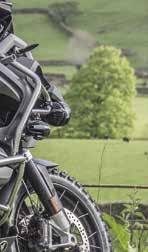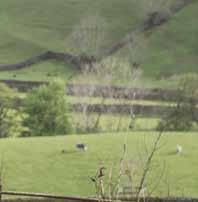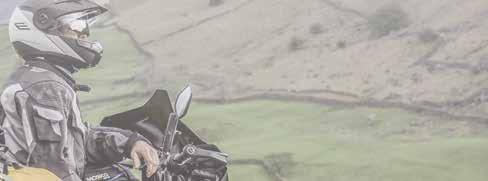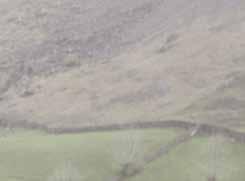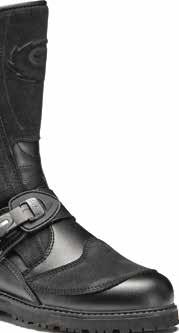






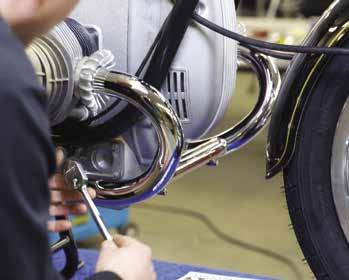


We also sell fully restored, partially restored, and project bikes. Huge used parts inventory. Learn more about our vintage BMW restoration and service and shop our parts catalog at www.maxbmw.com
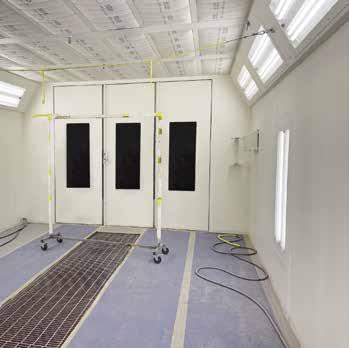 Fully-enclosed professional paint booth on-site
Full-service machine shop in-house
Vintage BMW-Certified Master Technicians
USA’s largest stock of new BMW Motorcycle parts
Fully-enclosed professional paint booth on-site
Full-service machine shop in-house
Vintage BMW-Certified Master Technicians
USA’s largest stock of new BMW Motorcycle parts
FLYOVER STATES
BY OWEN BOWER #226178
 BY JOHN "JP" PRIVETTE #160883
BY JOHN "JP" PRIVETTE #160883
4 | HEADLIGHT Difficult, but Positive Change
by Bill Wiegand8 | PRESIDENT'S COLUMN Time to Ride Again by Reece Mullins
10 | POSTCARDS FROM THE ROAD
12 | RIDER TO RIDER Letters from our Members
14 | NEWS BMW Motorrad partners with Backcountry Discovery Routes on new Oregon BDR, R 80 G/S up for grabs in MOA Foundation’s Completely Vintage Fundraiser, Hex ezCAN available at Ted Porter’s BeemerShop, BMW issues recalls for R 1250 GS/GSA/RTP motorcycles, National Motorcycle Museum to close, 2024 BMW Motorrad International Trophy set for Namibia, Where to Eat and What to Do in Richmond, 50th National Rally Ride Routes available via Ride with GPS

19 | CELEBRATING OUR 50TH ANNIVERSARY
Thank you MOA for 50 Great Years by Matt Goff
20 | GEAR Got a Favorite Tent?
24 | GEAR Sidi Adventure 2 Gore-Tex Boots by Dustin Silvey
28 | GEAR Wunderlich Adjustable Shift Lever by Mark Thompson
30 | KEEP 'EM FLYING Compressors and Fuses by Matt Parkhouse
54 | RIDER SKILLS Preaching. Practicing. Missing Deer by Nick Ienatsch
56 | MILEAGE CONTEST Congratulations to our 2022 Summer Mileage Contest Winners by Jim Low
66 | MILEAGE SLAVES What’s Your Number by Dave Cwi
70 | SHINY SIDE UP The Winter of My Discontent by Ron Davis
72 | THE RIDE INSIDE Momentum by Mark Barnes
76 | WHEN AND WHERE Rally listings
80 | TAILIGHT
ON THE COVER Ricardo Rodriquez, Lead Motorcycle Instructor at BMW’s Rider Academy in Greer, South Carolina, takes on a section of the new Oregon Backcountry Discovery Route. Photo by Ely


My wife and I have many conversations about doing something we’ve never done or going somewhere we’ve not visited. However, our new cross-country skis are still in the same spot and leaning against the same wall they have been since we brought them home last December, and our plans of traveling in Spain have never gotten past the “planning” stage.
Each day we wake up at the same time, pour the same cup of coffee, turn on the same news channel, and then proceed through the day with a routine planted deep within our brains many years earlier.
For the most part, humans don’t like change. Waking up at a different time, watching another network, or even taking a different route to work makes us uncomfortable. Despite our best intentions to change, we don’t. According to a study published in the Journal of Clinical Psychology, only about 46 percent of the people who make New Year’s resolutions are successful. If the recent pandemic showed us anything, it was that change is necessary for our survival.
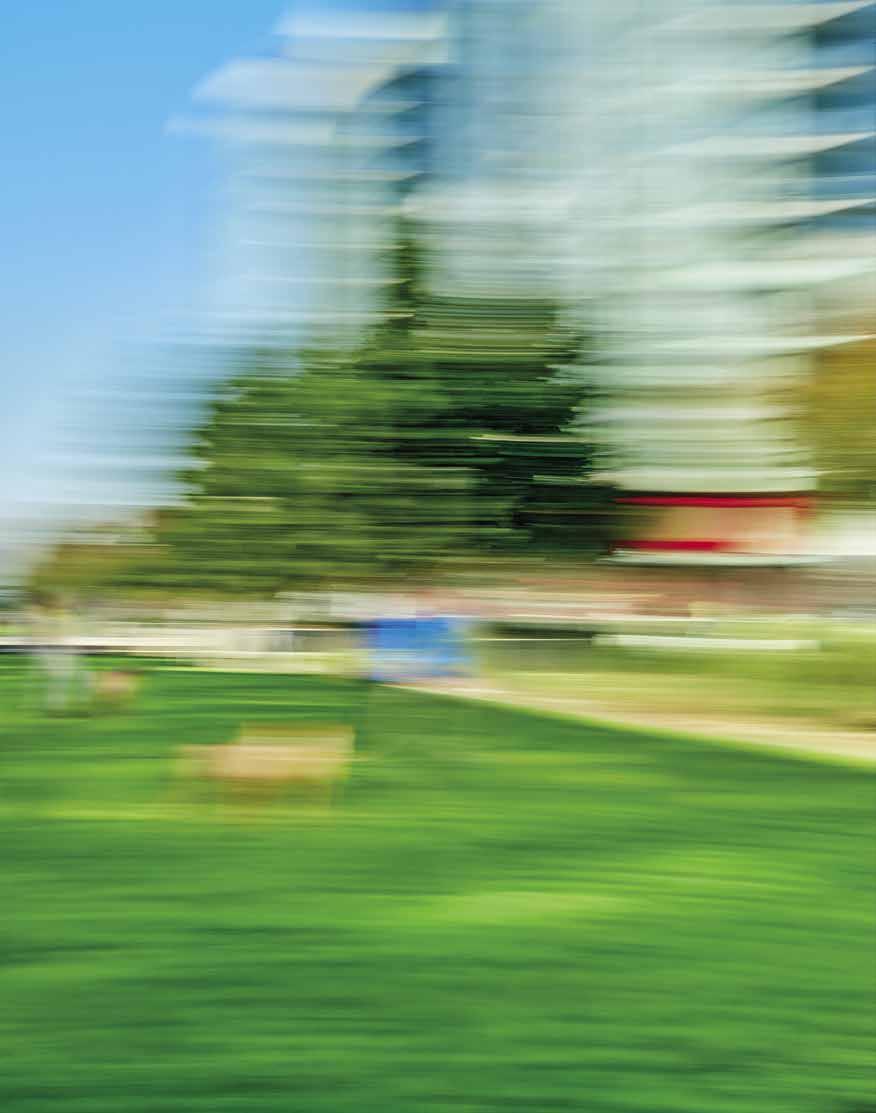
A little closer to the home all of us share, the BMW Motorcycle Owners of America has also stepped away from the comfort of our routine by making some changes. When pulling this issue of BMW Owners News from your mailbox, you may have noticed that the plastic wrapper used to ship the magazine each month is gone. Many years ago, poly bagging was incorporated to protect the magazine from the delivery damage some of our members were reporting. While some members applauded poly bagging, others deplored the use of unrecyclable plastic. This was a difficult change to make as, for years, we debated whether the poly bag’s protection was worth both the protection the bag provided and the cost, both monetarily and to the environment. Ultimately, we chose to forgo poly bagging and use the savings in ways more beneficial to our organization. While we expect to receive calls regarding magazines damaged by the postal service, should you experience this, please don’t hesitate to contact our office and ask for a replacement.
Once you realized this issue wasn’t in a poly bag, you may have noticed a new BMW Owners News logo atop the cover and, within the magazine itself, an updated layout with new headline and body copy fonts. Art Director Karin Halker and I spent many hours working on these changes, with the result chosen with readability and style as the primary criteria. We hope you enjoy them.
Additionally, some design elements within the magazine have changed along with a move from a perfect bound magazine offering a squared-off binding to saddle stitching. While saddle stitching has many benefits, sadly it does not provide the ability to stack 12 consecutive issues together to piece together an image as the previous binding method did.
Beyond all this, perhaps the most noticeable change has been our page reduction from 96 to 80. While there are fewer pages, the changes to what’s between the covers of BMW Owners News have allowed us to maintain an editorial content percentage similar to what we had before.
No doubt, change can be difficult, but we believe the changes we’ve made to BMW Owners News will be beneficial and that our readers will agree every month. The BMW Motorcycle Owners of America remains the great organization it always has been, and we look forward to serving all BMW Motorrad aficionados for many years.
As we approach our 50th Rally this summer in Richmond, Virginia, we look forward to the next 50 years, knowing the changes we make today will ensure a bright future for the BMW Motorcycle Owners of America.







The month of March has, for many years now, stirred a strong sense of excited anticipation of spring and of the renewed riding season for me. I say “renewed” as the latitude of lower Alabama accommodates year-round riding weather. Many members living in North America, depending on their degree of latitude, may experience similar emotions in the month of April, May, or even as late as June.
As exciting as rolling the bike out must be for the rider who has winterized their beloved steed (I have read of such sacred moments in Peter Egan’s writing), I can ride year-round. Still, spring is my favorite riding season. The earth is renewed and celebrates its new lease on life in a most spectacular way that is truly best to be experienced on the bike. The sun and the increasingly warm temperatures it brings are most welcome after months of frigid, gray and icy days. The forests and fields are emerald green and draped with the majesty of a variety of wildflowers: lilies and crocus, white dogwoods, pink azalais and lavender wisteria, all on brilliant display for the sensual emersion of the observant and grateful rider.
I believe there are several things we as riders can do to enhance and preserve the sacred nature of this annual ritual, training being paramount among them. Like the recommended replacement schedule for your helmet, if it has been more than five years since the last time you humbled yourself and signed up for formal instruction, you should seriously consider updating and refreshing your skillset. The oiling of these rusty habits and behaviors is just as crucial to improving your overall riding experience in the new year as the fresh oil you put in your bike. The relaxed, and confident mental and physical posture that is achieved through enhanced training improves every ride in every season, what the Army would call a “Force Multiplier.”

In the 1982 movie, Conan the Barbarian, Arnold Schwarzenegger’s character as Conan was asked, “What is best in life?” If I were to be asked the question today, the answer without hesitation would be, “To be on a well-maintained, freshly-serviced BMW motorcycle, highly trained, skilled, and relaxed, soaking in all that the world has to offer on a beautiful spring day.”
The long-time club member and riding aficionado will recognize the start of the riding season by the noticeable uptick in the rally schedule. Long time staples like March Moto Madness and the MOA Getaway at Fontana find their registration pages activate online and fill up quickly. I have learned that it is possible to chase spring. All the spring flowers are in bloom in lower Alabama in March, yet when attending the Fontana getaway in mid-April at higher latitudes and altitudes, I get the pleasure of experiencing spring all over again. The bouquet of fragrant smells, the cool moist air on my cheeks…I assume this can be achieved by any rider, regardless of their mailing address, as spring, like a warm ribbon of color, slowly moves north, eventually submitting to the inevitable heat of summer.
March also is the harbinger of the start and finish of our annual mileage contest. If our traditional contest doesn’t get your bike rolling daily this year, the MOA’s annual Coddiwomple contest is back and thriving. Whichever muse you choose, push the starter on that bike as often as you can each and every day.
Reece Mullins #143779 President


Center Bottom, Stopping at the Oark Cafe on our way to the MOA National Rally last summer. Unfortunately, they're closed on Tuesdays! Photo by
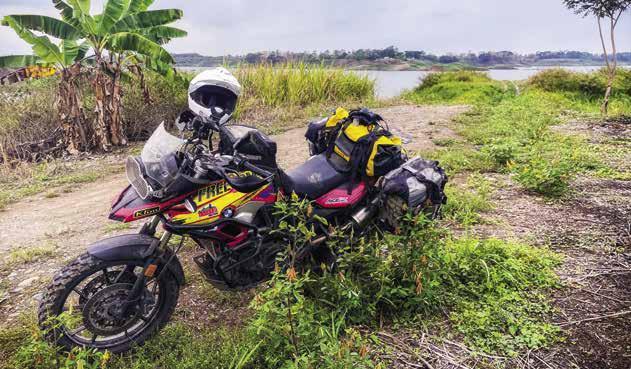
Far Right Top, My 2014 R 1200 RT on the Needles Highway–a spectacular drive through pine and spruce forests, meadows surrounded by birch and aspen and rugged granite mountains near Custer State Park in South Dakota, Photo
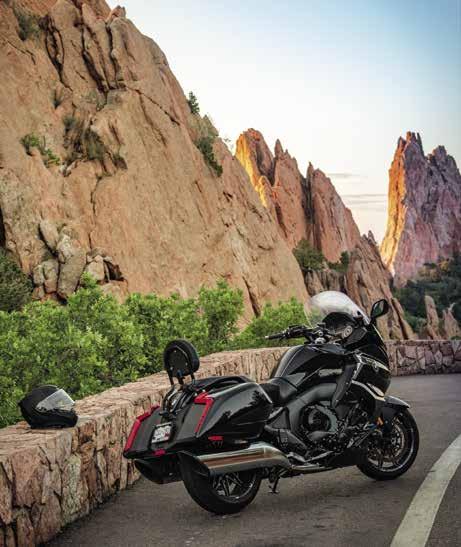
Far Right Center, Old Buckman Road at the Rio Grand River just outside Santa Fe, New Mexico. Directly across on the mountain is the White Rock overlook.
Illinois,
Above, With my F 700 GS somewhere in Ecuador. Photo by Scott Magruder #217969. Right, Amid the sandstone rock formation in the Garden of the Gods National Natural Landmark in Colorado Springs, Colorado. Photo by Mike Tice #231393. Center Top, A stop in the Okaloacoochee Slough Wildlife Management Area, one of the few places in south Florida north of the Everglades or Big Cypress National Preserve where the preColumbian landscape can still be observed. Photo by Graham Kier #225550.. Terence Hamill #14629. by Jack Chermak #48351. Photo by Jake Meadows #224740..Each month we publish the great images sent to us by BMW MOA members from their travels around the globe. Send us your best images and you could have your work published in our Postcards from the Road pages. Email your high resolution images, image description and contact information to editor@bmwmoa.org.


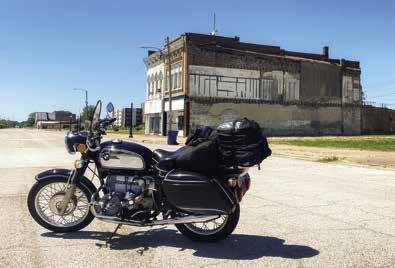


BMW MOA is a fine organization, and I very much enjoy being a member. The Rider to Rider section is a particular favorite, and as I read the January 2023 edition there is an inner need to voice “wishes and frustrations” as requested.
Like many members, I contacted BMW Motorrad regarding my absolute frustration that factory service manuals and tools will no longer be sold to “civilians.” I respectfully stated my use case and that I’m now lost as a future customer. I was as bold enough to detail there is a difference between “standard maintenance” and perhaps something of higher technical complexity in which I would seek dealer or warranty service regardless. I received a respectful response back from BMW that my frustrations would be listened to. Whatever….
Part of this frustration is that I expected more from BMW MOA considering its highly representative membership and frequent (very adamant) voices on this topic. After a year or so it’s now an ignored subject, but I have to believe it’s still near and dear to many members. I get it–it’s not an MOA problem, but something official voicing member concerns is not a big ask, run a member survey or such.
In the end I will not buy another new BMW motorcycle, and I guess when my beloved 2017 R 1200 GS is no longer part of my experience I will have no need for my MOA membership either. A very sad and unnecessary state to be in.
Brad Sallstrom #217981 Huntington Beach, CaliforniaI noticed you have an ad for Knopf Tours in Germany. I have used this company over 12 years while travelling in Europe, and my experience with Stefan has been fabulous.
I have been riding motorcycles for over 50 years, mostly in Canada and the US, but when I started going to Europe I lost most of my desire to ride here, other than off-road. I believe if you want the best experience with super roads, breathtaking scenery and reasonable travel it’s all there plus more.
You can ship and store your bike at Heidelberg via Knopf or any airline, stay a night or two, take your trip, return and leave the bike and your gear, and he even arranges a bus back to Frankfurt airport. Once you do it, you will go back and back again, as I and many more world travelers have. Check them out at knopftours. com–I’m sure you will not be disappointed.
Rick Westaway #54390 Penticton, British ColumbiaI enjoy reading BMW Owners News. Every issue shows me beautiful places I might visit someday and teaches me something about the sport of motorcycling that adds to my 20 years of experience riding BMW motorcycles. In nearly every issue, there are examples of the best part of being part of the BMW riders community: support of BMW owners by BMW owners and the BMW dealer network. I admire those that can repair and maintain their BMW motorcycle(s), but that is not me. The support of a dealership that is reasonably close to my home is an important part of what I consider to be a quality BMW ownership experience.
As important as I find the support of a BMW dealer to be, I thought it necessary to share a polite warning with BMW Owners News readers that not all dealers are created equal.
The story behind this warning is about a 2018 K 1600 B Bagger in apparently pristine condition with less than 2,000 miles on the odometer that was purchased early in 2022 and now lives near Knoxville, Tennessee. Very little riding of this Bagger after purchase exposed an issue not shared by the seller. The motorcycle exhibited inconsistent throttle control and without warning would switch into “Safe Mode” displaying engine fault indicators.
Three separate visits to the closest BMW dealer in Tennessee only resulted in shop repair bills, but no fix for this potentially dangerous problem. Phone conversations with the Service Manager at the next closest BMW dealer in Tennessee resulted in a polite refusal to accept the motorcycle for repair and a request to take it elsewhere. Out of frustration, I contacted BMW of Denver where I have purchased a number of BMW motorcycles. They have supported me very well over many years. BMW of Denver was willing to accept the challenge. Once the Bagger was transported to their shop, they correctly diagnosed and repaired the problem (unstable control signals due to wiring harness connector issues).
My brother rode his 2018 and I rode my 2021 Bagger nearly 1,700 miles from Colorado to Tennessee this past October. A wonderful ride made possible by the support of a dealer organization where some dealers are “more equal” than some others. I hope everyone reading this has the good fortune to find support of the same caliber.
Wayne Nelson #144086 Centennial, ColoradoI am sure I represent about 300 million jillion other readers when I say, please print more of Jack’s articles. They are GREAT!
Robert Hays #228747 Pearl, MississippiI disagree with the letters and comments regarding plastic rally gear that I’ve seen in the last two issues in the BMW Owners News
I have been to around four rallies, and I find the plastic beer mugs a perfect way to remember the year and destination of such rallies. Without them, it’s difficult to recall, particularly the year.
Stephen J. Corbett #168638 Jamestown, Rhode IslandWith all the good things BMW MOA bring us, I’d like to challenge our Board to consider a new initiative for its members: advocating for European Delivery of BMW Motorcycles.
We can simply hit the “easy button” and accept the impossibility of it, but I suspect that the synergies of the motorcycle lobby (BMW MOA included) could elevate the discussion to our fellow government representatives. I’m confident some of the slippery bureaucrats ride motorcycles, too, and would be first in line to ride over there and ship it here.
Maybe the idea is too simple and makes too much sense to those of us who desire to ride in Europe, but maybe that’s one reason I belong to BMW MOA.
Tony Keyser #161705 Leavenworth, WashingtonA friend and I started from our homes in northern California on a longtime bucket list goal of riding from coast to coast on many of the iconic motorcycle roads this vast country has to offer. We headed out on September 1 in search of as many
great motorcycle roads as we could find–Rick on his 2019 R 1250 RT and me on my 2014 R 1200 RT. As we have both spent many years and countless miles exploring the west, we buzzed through it, and the heat, on I-80 until we got to Nebraska and Hwy 2. We left the super slab behind at that point on our eastward-bound adventure. We enjoyed county roads, state highways and cooler temperatures through the northern Plains states.
After we arrived in Ohio, we spent a fun, full day on the various moto loops out of Zanesville. It had been a glorious trip so far with a little over 3,000 miles behind us when we left town early on September 9. I was leading that morning on Ohio’s Triple Nickel. While cruising at a relatively modest speed due to morning fog, without warning, a deer seemingly dropped from the sky immediately in front of me. With a lot of luck, and maybe a little skill, I kept the bike upright and pulled to the side of the road. I was unscathed but both the deer and my bike didn’t fair as well. Cell service was poor and none of my roadside services were able to find help. Once a tow was finally arranged through MOA. I sent Rick on down the road with the promise of catching up with him as soon as I could.
My bike and I were taken to Columbus and Motohio European Motorbikes while I talked to my insurance company and called my cousin Dan who lives there and graciously agreed to put me up for a couple of days as well as chauffeur me back and forth to the dealer.
I considered a number of options to my dilemma, including flying home and coming back for a repaired bike, which would have abandoned Rick and aborted my trip leaving him solo. Or renting a bike for the remainder of the trip east only to have to come back and wait for an indefinite amount of time for repairs to be completed and still have to part ways with Rick. None of the options considered sounded good. My daughter, who has always disliked the fact that I ride a motorcycle, said “Dad, just buy a new motorcycle.” I asked her to repeat that as I couldn’t believe what I was hearing from her. As many know, new RTs were generally unavailable on showroom floors in most of the country then as most buyers have to order and wait
months to obtain one.
Once again Lady Luck was smiling at me because that Ohio dealer had just received a new 2021 model through a factory incentive with six miles on its clock that was unspoken for. All of a sudden, my options were looking brighter, and they became blindingly bright when, after telling my wife and money manager, what our daughter had said, the love of my life said, “Buy it!”
After swapping the stock seat for my Sargent and mounting my loaded top case I caught up with Rick in upstate New York by way of wonderful back roads. We continued our winding trip to the eastern most point of the U.S. in Maine and then turned west to head home by way of the top of Mt. Washington, through Shenandoah National Park, the Blue Ridge Parkway, much of Natchez Trace, the Tail of The Dragon and more glorious riding on a brand new and amazing motorcycle.
We finally got on I-40 for the last leg until we could cut off to CA-395 and complete our journey up the eastern side of the Sierra Nevada mountains. Rick and I parted as he continued north while I turned off at Monitor Pass for home. After a total of almost 10,000 miles, I arrived home on October 4. It was the trip of a lifetime, and I’m so grateful that Rick asked me to accompany him. We had a ball and are even better friends now.
The R 1250 RT is a dream to drive and performed flawlessly for the 6,525 miles from Cincinnati east and then back home with one stop for break-in service at Hermy’s BMW in Clinton, Ohio. It’s now in need of its next service and new shoes before my next ride through the foothills and my next adventure.
Here’s a shout out to the people at Motohio European Motorbikes and BMW of Cincinnati including the owner, Mike, who were kind, attentive and did what they could to get me back on the road as quickly as possible. The same goes for the folks at Hermy’s who squeezed me in for my 600-mile service and had me riding away in a couple of hours.
GEICO graciously totaled my ‘14 RT and provided me with a generous check.
Kevin Cole #158695 Placerville, California
BMW Motorrad USA recently announced its second partnership with adventure motorcycling non-profit Backcountry Discovery Routes on their newest route in Oregon. This is the second BDR route on which BMW Motorrad has collaborated, the first being the Wyoming BDR, released in 2022.

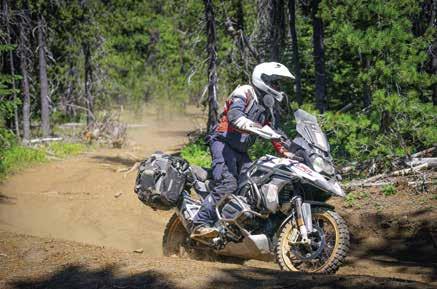
The ORBDR represents the organization’s twelfth route for adventure and dual-sport motorcycle travel, with free GPS tracks, travel resources, and a Butler Motorcycle Map scheduled to accompany the film’s debut.
“BMW Motorrad is proud to partner with Backcountry Discovery Routes once again, and for a second time in two years, in the creation of the new Oregon BDR. In 2023, BMW Motorrad celebrates its 100th year anniversary and also marks 43 years of BMW GS motorcycles. This is the perfect time to share our passion for the adventure and dual-sport riding communities and show our continued support for the BDR organization and what they stand for,” said Luciana Francisco, Head of Brand and Marketing, BMW Motorrad USA.
“I grew up in the Pacific Northwest and have always been fascinated by volcanoes. The ORBDR is a route filled with natural wonders of the volcanic kind. We designed the ORBDR to show off different regions of the state and keep the route ever-changing. Oregon has vast high desert in the southeast, sparse pine forests in the central part of the state, and densely forested mountains in the Cascade Range. It almost feels like three BDRs packed into one,” said Bryce Stevens, Oregon Route Architect and BDR Co-Founder.
Joining the expedition team in Oregon was Ricardo Rodriguez, Lead Motorcycle Instructor at BMW’s U.S. Rider Academy in Greer, South Carolina. Ricardo is a graduate of BMW’s rigorous International Instructor’s Academy and has been teaching on-road street survival, adventure off-roading and authority riding skills since 2010.
“The BDR Team has set out on a fantastic mission, helping keep public lands accessible to the adventure community. I am very proud and excited about the relationship between BDR, BMW Motorrad, and the BMW U.S. Rider Academy. Having the opportunity to be a part of the Oregon BDR has helped build my experience as a rider and a coach. Overcoming the challenges along the ORBDR reinforced to me the value of the skills we teach daily at the U.S. Rider Academy,” said Rodriguez. “Backcountry Discovery Routes offers properly trained riders an opportunity to put their skills to the test. The Oregon BDR is a challenge and a rewarding riding adventure.”
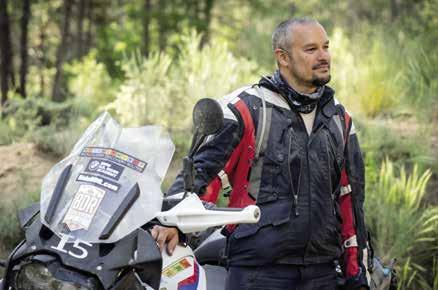 "Having the opportunity to be a part of the Oregon BDR has helped build my experience as a rider and a coach," said Ricardo Rodriquez, Lead Motorcycle Instructor at BMW's Rider Academy in Greer, South Carolina.
"Having the opportunity to be a part of the Oregon BDR has helped build my experience as a rider and a coach," said Ricardo Rodriquez, Lead Motorcycle Instructor at BMW's Rider Academy in Greer, South Carolina.
The BMW MOA Foundation's latest restoration project, a 1981 R 80 G/S, is up for grabs in the Foundation’s spring “Completely Vintage” raffle. Designated as the world’s first adventure bike, fewer than 22,000 units of the R 80 G/S were built. One lucky MOA member will take home this fantastic survivor on April 22, 2023.
The Foundation found the highly desirable boxer on eBay nearly three years ago and started the process of restoring it for the Completely Vintage raffle. After two failed attempts to deliver the bike to Canada during the COVID lock down to MOA member John “Dutch” Lammers for restoration, the process finally began in late 2021. The result is a beautifully restored example of one of the most iconic BMW motorcycles ever built.
Tickets for the Completely Vintage raffle are available for purchase between January 29 and April 8, 2023, at bmwmoaf.org or by calling the MOA membership office at (864) 438-0962. The live winner’s drawing will take place April 22 at the MOA Getaway at Fontana. The drawing will be broadcast online, and members may attend in person.
The Completely Vintage fundraiser benefits the BMW MOA Foundation and its mission to advance rider safety, education and training. According to MOA Foundation President Tom Gary, the popular fundraiser will fund all the Foundation’s rider training activity for a full year. Complete details and more information about the R 80 G/S build are available online at bmwmoaf.org.
The Hex ezCAN plugs directly into your bike and listens to the digital signals on your bike’s CAN-bus. It turns those signals into voltage outputs which you can use to power a wide variety of electrical accessories using your existing controls and switches with no need for power hubs, relays, or extra switches, and no need to splice into your wiring harness. Plug in additional driving lights, tail/brake lights (with optional flash feature), a better horn, or the lighting harness from your trailer or sidecar. Use the ezCAN in the factory presets or fine tune how you want your accessories to function with the included, user-friendly Mac or PC software. Adaptor cables are available for easy plug-in connection of well-known lighting brands such as Baja Designs. The optional extension kit includes wiring harnesses and additional connectors which can be added to any electrical accessory for an easy plug-and-play install.

Beemershop originally introduced Hex products to the USA back in 2007 and has extensive experience and a large inventory of all Hex products. For more information, visit beemershop.com.
BMW Motorrad and the National Highway Transportation Safety Administration issued campaign number 23V011000, recalling about 18,500 BMW R 1250 GS, GSA and RTP (authority) motorcycles for a problem with the gearbox input shaft.

According to the recall notice, under certain operating and riding conditions the gearbox input shaft may become damaged or break, possibly resulting in a blocked rear wheel. The remedy for this problem, according to the recall notice, is an update to the engine control unit’s software, which will be performed for affected motorcycles without charge to their owners. That the solution is a software update indicates there are no faulty parts needing replacement. Owners of affected motorcycles should receive a letter starting in mid-March 2023, after which they can contact their dealer to get this recall service performed.
The specific affected motorcycles are:
• 2019-23 R 1250 GS
• 2019-23 R 1250 GSA
• 2019-23 R 1250 RT Authority
This is the sixth recall affecting R 1250 GS/GSA motorcycles; it is the first one since 2020, when BMW issued three recalls for brake-related problems affecting fewer than 10,000 motorcycles combined. Also in 2020, BMW issued a recall of about 4,000 motorcycles related to flashing brake lights. Another recall for a final drive pivot pin issue which affected only four motorcycles was also issued in 2020.
Owners can contact the NHTSA (888-327-4236) or BMW Customer Service (800-525-7417) for more information.
After nearly 22 years in Anamosa, Iowa, the National Motorcycle Museum announced in a Facebook posting that it will close in September and auction off much of its collection.

The closure will come about 5 1/2 years after the death of museum co-founder John Parham following a long battle with pulmonary fibrosis. His widow, Jill, is chair of the museum’s nonprofit board, which said in a news release that the decision to close came after several years of struggling to cover the cost of wages and utilities, “partly due to low visitation.”
With his wife, John Parham founded and ran J&P Cycles, an Anamosa national motorcycle parts company now run by their son, Zach. The company also runs a pop-up store each year in Sturgis, South Dakota, during that city’s world-famous motorcycle rally. In 2001, the Parham’s moved the museum from Sturgis, where it had operated for 12 years, to Anamosa.
The Facebook post said the museum has contacted the owners of loaned motorcycles and that motorcycles belonging to the Museum “will be liquidated at auction to pay bills,” adding that much of the Parhams’ personal collection also will be sold.
It said motorcycle enthusiasts who want to be informed about the sale should sign up to receive emails at the museum’s website, nationalmcmuseum.org.
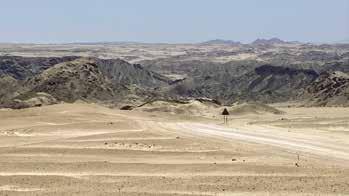
Having been held on all continents around the globe, the International GS Trophy now returns to where it all began in 2008: Africa.
Namibia’s fascinating attractions include magnificent landscapes, as well as unique flora and fauna. When night falls after a hot day has drawn to a close with a deep red sunset, a spectacular starry sky stretches out over this paradise located on the Atlantic coast of southwestern Africa. In short, the journey into fascinating Namibia will be an entirely unique experience in many respects and well-seasoned with a good portion of SpiritOfGS.
National qualifying rounds and the first international qualifying round for an International Team will be held at the 2023 BMW Motorrad Days.
There is still some time to go before the official start of the BMW Motorrad International GS Trophy 2024, however. Meanwhile, the national qualifying rounds offer a taste of what is to come. There will be 15 national qualifying events and one international qualifying round worldwide, giving skilled endurance specialists the opportunity to demonstrate their capabilities.
In order secure a place on one of the 22 national teams, participants are required to perform GPS navigation exercises, off-road rides and technical tests. The women’s teams that prevail at national level will win a trip to the international female qualifying round, where a total of six women’s teams will be selected for the much-coveted seats on the plane to Namibia, along with the 16 men’s teams.
The BMW Motorrad International GS Trophy celebrates the spirit of the legendary BMW Motorrad GS models. It encompasses everything that a BMW GS stands for: riding fun, adventure and challenges. The BMW Motorrad International GS Trophy 2024 Namibia is the ninth edition of the event. Previous editions were held in Southeastern Europe (Albania) in 2022, Oceania (New Zealand) in 2020, Central Asia (Mongolia) in 2018, Southeast Asia (Thailand) in 2016, North America (Canada) in 2014, South America (Chile, Argentina) in 2012, South Africa (South Africa, Swaziland, Mozambique) in 2010 and North Africa (Tunisia) in 2008. The current event will involve 22 teams from all over the world with a total of 60 riders.
For more information, visit gstrophy.com.
When you come to the Richmond area for the 50th, you'll have to eat. Whether it's during the Rally itself or on your way into or out of town, Perly's in downtown Richmond is worth a stop. A word to the wise–get there before traditional mealtimes, as tables go quickly and the locals know all about this place! The upside is Perly's does a brisk take-out business, so if you can't eat in, you can always grab your meal to go.
Roadfood called Perly's one of the best places in the area to eat, saying, "The staff here serves meals with enthusiastic good cheer."
Perly's is closed on Mondays and Tuesdays, then open Wednesday through Sunday from 9 a.m. until 3 p.m., making it the perfect breakfast, brunch or lunch stop. Set your GPS to take you to 111 E Grace St, Richmond, Virginia, 23219, and don't forget you can order your take-out meal ahead of time through their website, orderperlysrichmond.com.
When you've finished your meal from Perly's, head NNE and visit the Maggie L. Walker National Historic Site or go straight north and head to the Black History Museum and Cultural Center of Virginia. The Virginia State Capitol complex and Virginia Executive Mansion aren't far to the SSE, and you can take in some Civil War history at the nearby White House of the Confederacy, which is part of the multi-location American Civil
War Museum. Head even deeper SSE into the city, venturing into the area known as Shockhoe Bottom and take in the Poe Museum (celebrating over 100 years since its founding as the Poe Memorial Association) or the Virginia Holocaust Museum.

Perly's is walking distance from two iconic Richmond inns, Quirk Hotel and The Jefferson, the city's longest-running five-star hotel. The Graduate (popular with people visiting VCU) isn't far off, and there are locations of the Holiday Inn Express, Marriott, Hilton and Hampton Inn & Suites nearby as well.
Ready to explore the unbeaten path? New to Virginia and want to know the best-kept local secrets? We get you! We're building a library of ride routes using “Ride with GPS” to help you find all the cool places on the way to and from the 50th!
Known roads, like Blue Ridge Parkway, Skyline Drive or even the Mid-Atlantic BDR have so much information available about them, we would be just recycling the same material. We want to help you find the best routes to the rally grounds if
a couple of days of touring an area is not an option. How about new places off the beaten path instead? Let us introduce you to those. We especially want to help you avoid that white knuckle ride on I-95 from either direction on the east coast. Along the way, we’ll introduce you to some routes that side-step the Richmond, Baltimore and DC metro areas. These routes should help you be more relaxed when you get to the Meadow Event Park in Doswell, Virginia.
And let’s face it, seminars are great, and there are plenty of new things to see at the Rally, but you’re also on a long ride, and getting out for a few hours to cool down and have a great bite to eat each day is good as well. So, we’re also going to have some great day rides from the rally for you as well.
For more information regarding the library of rides we’re gathering for rally-goers, please visit the Rally website at rally.bmwmoa.org. See you in Richmond!
While I haven’t been a BMW MOA member for 50 years, at 51 years of age, I might be the youngest oldest member.

I was a tank baby of sorts–my dad had an R 90 back in 1974, and I rode between him and the tank until I was old enough to reach the pegs and ride pillion. I had one of those roundish helmets with the big bubble face shield and appreciated the hyper-experience of everything around me. I loved the sound, the vibration and the wind as it seemed to work its way into the openings of my jacket. I could feel the temperature changes in elevation and the shadows on the road. I recall my dad carving out mountain roads and passing slower vehicles on straight stretches. I would hold on a little tighter as he rolled on the throttle.
I felt pride riding on a BMW. I remember believing that there was no better motorcycle than my dad’s bike, and that all other makes and models were inferior. No offense to those who ride other brands, but that was my five-year-old mindset.
I didn’t have many responsibilities back in 1976, but one of them was to retrieve the mail that was delivered to the box at the curb each day. Back then, and even now, the monthly arrival of the BMW MOA’s monthly magazine is one of the most eventful parcels to arrive from the postman–I have read every issue of the magazine since then. You might be questioning how well a five-year-old could read. The answer is that the pictures were the most important feature of the publication. When I collected the mail and brought the magazine into the house, the
first thing I did was start flipping through the pages and cutting out the pictures to paste up on my bedroom wall. By the time my dad got his hands on the magazine, he was left with a slightly aerated and unreadable version. That is how I became a BMW MOA member at
rides and end up staying the night at a campground. We would stake a tarp off the side of the bike as a makeshift tent. The heat from the engine would keep us warm as we went to sleep. We would wake up chilly the next morning and ride to the nearest coffee shop for breakfast pancakes.
Like many kids, I rode minibikes and dirt bikes before I was old enough to get my motorcycle endorsement, and when I did, I bought one of my dad’s R 90s as my first road bike. It was black with a Hannigan faring. I remember it being a challenge to take the riding test at the DMV with that bike. I had already been riding motorcycles for a decade, but I recall negotiating the tight turns was especially challenging. It may have been because dad was watching. As time passed, he frequently reminded me to practice and not be complacent.

the age of five. My dad signed me up as a MOA member so I could have my own source for BMW motorcycle pictures. If he had known my interests in BMW motorcycles would continue so long, he probably would have signed me up as a lifetime member.
My dad had a few BMWs through my childhood. He had an R 69, a few R 90s, and an R 100 with a side car. I loved going on long rides, camping trips, and rallies with him. Everyone at the rallies was always friendly. I liked the stories people would tell. I enjoy the rallies but miss the long rides with my dad the most. Sometimes, we would go for weekend
My current BMW is an R 1200 GS. I follow my dad’s advice by regularly practicing braking, picking good lines and navigating obstacles. Occasionally, I pick an empty parking lot to practice low speed control techniques. I owe being still alive to continued practice. I don’t get many opportunities to go to rallies anymore. I will probably go to the national rally the next time it’s closer to the west coast, and I still have a European road trip and a weekend at RawHyde Adventures on my bucket list.
Being an MOA member has been a positive experience. I also still enjoy reading BMW Owners News about new technology, riding tips and everyone’s adventures. Of course, the pictures are still my favorite. I don’t, however, cut the pictures out and paste them on the wall anymore.

Whether you want to stand up, sit down or squat awkwardly to get dressed in the morning, there’s a tent to fit your bike, lifestyle and budget. We recently polled the MOA Facebook group to get an idea of what tents our members use, and here are some of the most frequently mentioned.
Nemo Dagger OSMO 3-person www.revitsport.com
"If I’m covering a lot of turf and not staying in one place for long I take my Nemo Losi 3P. It has a dog proof inner liner and enough room inside for gear or to prevent scratches on my back when Glenlivet dreams."
(LOSI discontinued, OSMO now being offered)
"The main reason I use this is because bears always avoid green tents! It also light and packs small."
Eureka Timberlines 2 or 4-person www.eaglesnestoutfittersinc.com

"Easy set up and take down and plenty of room for people and bags/trunks."
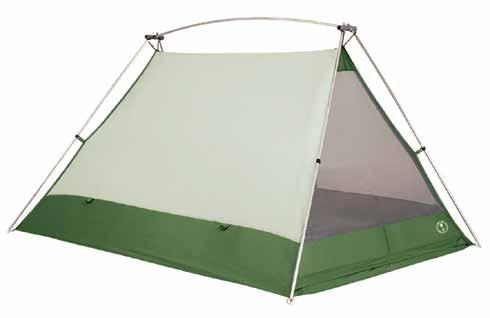 – Richard Rowlands #228699
– Peter Burke #133958
– Richard Rowlands #228699
– Peter Burke #133958
www.redverz.com
"If I plan on staying in one location for a few days (like at our rally) nothing beats my Redverz. Tons of room inside, the garage provides shade in sunlight and dry space in rain, and it is remarkably easy to set up and break down."
"Even though I have a number of other tents from Big Agnes, MSR and Hilleberg, the Redverz tent has become my go-to tent for motorcycle, kayaking, and car camping trips."
"Redverz has proven to be far more comfortable than a standard tent. Getting older, we have found the Atacama far easier to get in and out of and we can use our camping chairs inside while getting dressed and undressed. It will also accommodate a queen-sized air mattress. It has proven to make camping much easier for us!"
www.msrgear.com
"Large vestibule to store your riding gear in. Quick setup and packs relatively small. Not as cool as a 'park your bike in there' tent, but you can still put on/store your gear out of the weather."

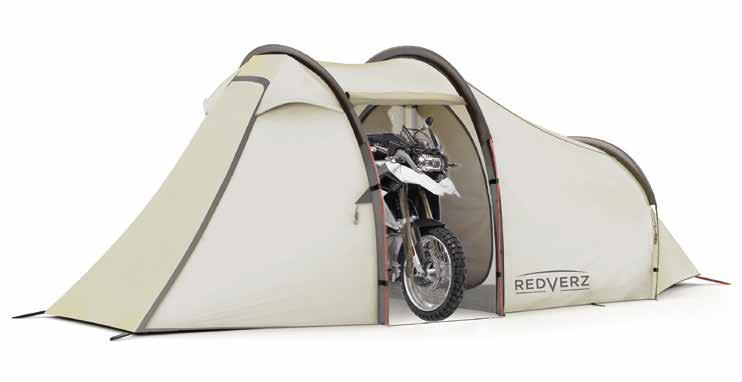
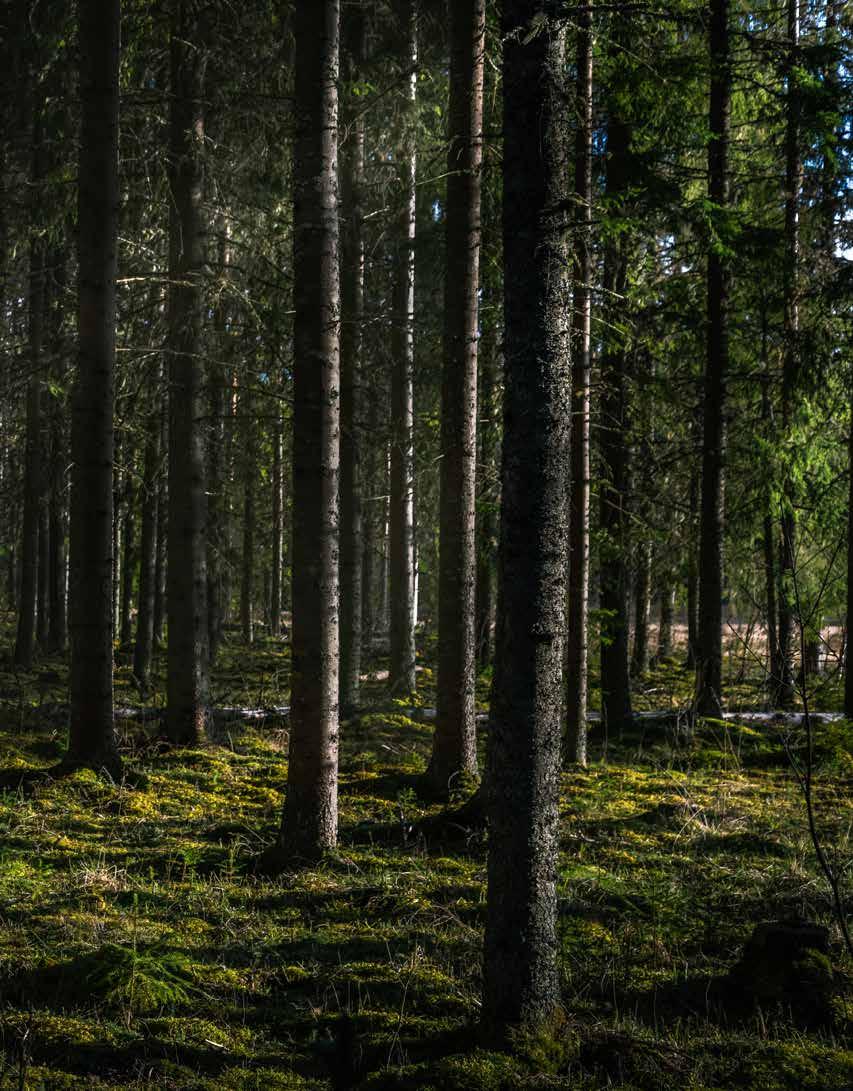 MSR Hubba Hubba 2-person
– Mike Bobbitt #209066
Redverz Atacama Expedition Motorcycle Tent
– Peter Burke #133958
– John Morris #224317
MSR Hubba Hubba 2-person
– Mike Bobbitt #209066
Redverz Atacama Expedition Motorcycle Tent
– Peter Burke #133958
– John Morris #224317
www.alpsmountaineering.com
"It has heavier nylon, larger, more durable zippers, and a full coverage rainfly that goes all the way to the ground. Very dry! Bigger than a backpacking tent, but small enough to get on the bike. Its a dome style tent with plenty of room and two-aluminum-pole setup. BOOM!"


– Ted Moyer #100360
Eureka Scenic Pass 2
"Light, strong, compact, weather proof, with a door on either side and a twin vestibule fly, it's got great ventilation and sets up in under five minutes. Coupled with a Helinox bed, it's great. This is my second one over 20 years."
– Mark Morrissey
www.vango.co.uk
"Great touring tent. Plenty of room for gear and to spread out when you may get stuck in one spot due to weather."
– Paul Hughes #231920
www.eaglesnestoutfittersinc.com
"Stays in one side bag along with a lightweight sleeping bag and rain gear - just need one LT and one tree to hang it from, stay off the ground and sleep better."

(alternative mentioned - Clark NX270 Jungle Hammock)
– Sean Epperson # 224834
www.bigagnes.com
"My favorite tent thus far. Freestanding setup and in inclement weather, the footprint and rain fly can be set up first, keeping the tent dry for sleeping. Vestibule is large and allows gear to be stored out of the elements. Packs down small being a bike pack tent. I spent almost eight weeks on the bike living with this tent, with only seven nights spent in a motel total."

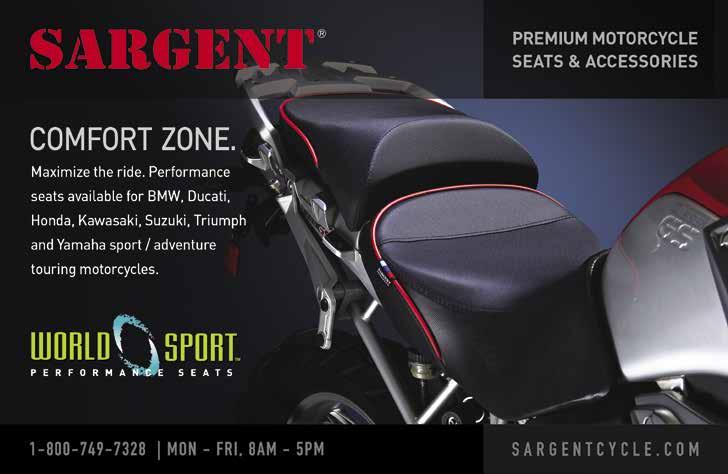
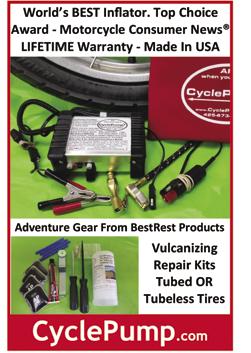


A semi kicked up a wave of water that hit me hard, covering me from head to toe. I felt that horrible feeling of water coming up under my Gore-Tex jacket to soak my underlayers. I thought to myself, “Well, this day just keeps getting better and better.”

The day had started out pretty well—a bit cold, but the sun was shining—and Janel and I had high hopes of a warm ride. We stopped for a quick breakfast at Robin’s Donuts, and as we pulled out of the bumpy parking lot, a drizzling rain started. Janel and I both agreed that a little cold and drizzle wouldn’t stop us today; plus, we had our Gore-Tex gear to keep us dry. However, about an hour later when we pulled off for gas, the sky opened up and gave us all it had. When I went to pay for the gas, the station attendant asked, “How far are you riding in this weather?” I told him we were headed to Thunder Bay about 480 km (300 miles) away. He said “Wow, you two are nuts! The weather is supposed to be like this for three days!”
After several hours of torrential rain, we arrived at our hotel in Thunder Bay. We were both soaked under our jackets, and the tops of pants were damp. There was just so much moisture in the air that without an actual sealed dry suit, there was no way to keep ourselves dry. As we tore off our wet clothes, I pulled out a hair dryer to start drying our gear. When we both took off our riding boots, we realized our socks and the inner lining of the boots were warm and dry. The only part of our gear that wouldn’t require a hair dryer that evening was our Sidi Adventure 2 Gore-Tex boots.
Janel and I were confident that we were going to ride through a rainstorm at some point during our cross Canada trip, so we both wanted to make sure we had the right gear to alleviate our suffering. I’ve always worn motocross boots for riding; I like to go off-road and prefer the additional protection of a high boot, and we wanted something similar for our trip. We also wanted a boot that would allow us to do short hikes. The Sidi Adventure 2 seemed like the perfect fit for our needs.
The Sidi Adventure 2 boots have a Gore-Tex liner, and it worked hard at keeping our feet dry. Not once during our entire 120-day trip did we need to dry out our boots after a rain storm (and we rode through a lot of rain storms). I am sure most people reading this know having wet feet is not a pleasant
experience, especially when it starts to get cold in the Canadian fall or while riding through a Montana snow storm in May (we did that, too). The outside of these boots is not Gore-Tex, so there is a bit of absorption of water which does add weight to the boots as the day progresses. For water proofing, I give the boots a 9/10, if only because it’s the liner rather that keeps you dry.
The boots have two buckles on the lower half and a top Velcro flap. This adds a lot of extra comfort because you have the ability to move your leg around when you ride and walk around. I like the comfort; however, I do prefer the support of three or four buckles in case of a crash. The boots still have all the safety measures you would expect from a high boot of quality: a shin plate, plastic to support the ankle, and a heel cup (as someone who broke their heel before, I appreciate this). When Janel went down on the third day of our trip, the bike landed right on top of her leg. That evening after we made it to our hotel she complained of a sore ankle. After a little ice and Advil, she was ready to ride the following day. Janel wasn’t going fast when she dumped her bike down that ditch, but the fact that she was in only a small amount of pain after she skidded in the gravel with the motorcycle on top of her ankle tells me the boots held their own on the protection front. Rating for protection, I give the boots a 9/10. Only because I prefer the top buckle/s.
The soles of the Sidi Adventure 2 are thick, which helps absorb some of the vibration of our thumpers, and they have grip like any good work boot. With this type of sole, we were never worried about slipping on wet pavement. The boots are designed to be used for short walks, hence the top Velcro flap. This flap, rather than one or two more buckles, allows for ankle dorsiflexion (the shin to move more forward) when walking. The design prevents fatigue and eliminates the funny ski boot type walk a lot of people have in motocross boots. While on our trip, I had the opportunity to test out the boots during a hike, walking a six-kilometre (3.75 miles) round trip to Western Brook Pond on the west coast of Newfoundland. I had always wanted to see this famous fjord and thought this would be the perfect opportunity to test out the Sidi Adventure 2 with some real
hiking. Although it was a well-manicured trail (wide enough to support wheel chair access) it was a bit of up and down, and I took the boots through the paces. My feet never got sore, but I was fully aware of the fact I had motorcycle boots on. I got tired more rapidly from the additional weight and did feel a hot spot on the back of my right ankle (dominant leg). Overall, as far as hiking in high motorcycling boots goes, I can’t imagine there is a much better boot out there. I think for short hikes, I would give these boots an 8/10. The hot spot was annoying, and the boots are heavy. For anything longer than what I did that day in
Newfoundland, I would certainly bring a change of shoes. Would I buy the Sidi Adventure 2 boots again for another cross-country road trip? 100 percent yes. But I don’t need to, my boots are still like new after 28,000 km (17,400 miles). Rain, snow, mud, rocks, dust and falls couldn’t damage these boots. For waterproof touring protection that will last, I fully support the Sidi Adventure 2 boot at a price of US $449.99. If you give them a try, hopefully you have the same experience as us (with the boots, not the ridiculous rain storms).
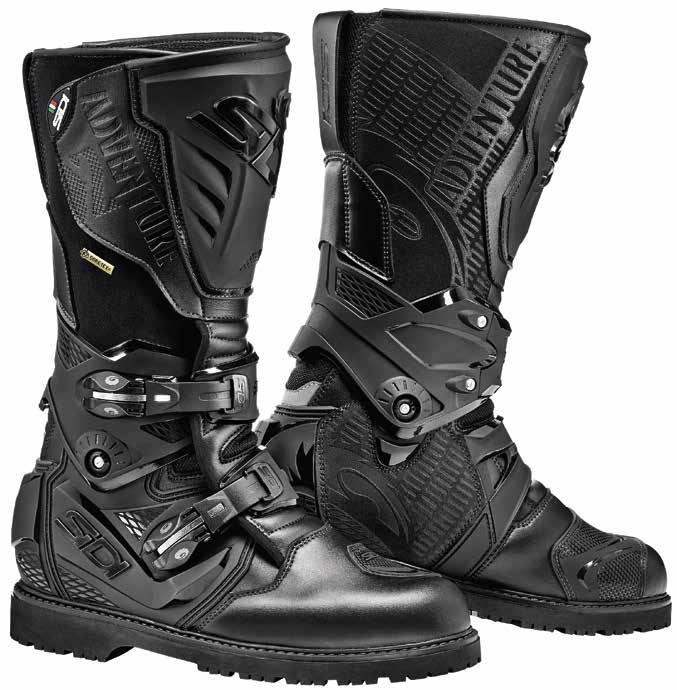






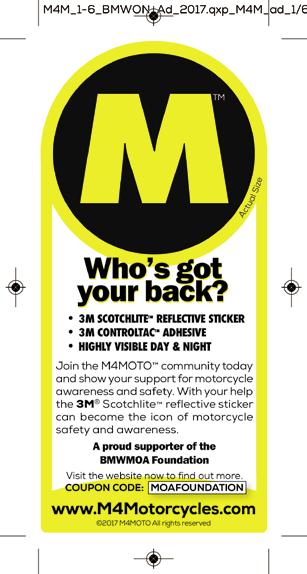
Having adjusted and readjusted the position of my 2022 R 1250 GS Adventure’s shift lever multiple times yet still never finding the sweet spot allowing my size 10½ boots to happily coexist with the lever, I found a way to remedy the problem with Wunderlich’s adjustable shift lever.
Besides adjusting to fit any size boot, you can choose to have the shifter higher or lower than stock, depending on which of three bolt holes you choose on the Wunderlich’s mounting plate. The shifter tip is stainless steel and spring-loaded, offering peace-of-mind in the event of a tip-over. Few things will leave you more forlornly stranded by the side of the road or trail than a broken shift lever—been there, done that, don’t want to do it ever again.
The Wunderlichlever itself is a thing of beauty, as befits its jewel-like price. Made of CNC etched 7075 T6 aluminum, it’s shaped much differently than the plain-Jane stocker.
Now I’ve raced motocross for decades and can do a twostroke top-end rebuild using a rusty crescent wrench and two tired cliches plus an enormous toolbox, so I expected to breeze right through this installation. Wunderlich’s instructions say “35 minutes” for the job, but plan on an hour because the instructions are those “guess what the photo is showing” type that too many manufacturers use these days (I blame IKEA). My profession for many years was writing/editing home and auto repair manuals that gave you all the necessary information to get the job done with minimal confusion, so let me save you a lot of time figuring out what size fastener you’re dealing with and digging around in your toolbox.
For my ‘22 R 1250 GSA I needed these tools:
• Torx bits in size T20, T25, T40 and T60
• Metric wrenches/sockets in sizes 7, 10, 11 and 13mm (It helps if your 7mm and 10mm wrenches are “thin” ones because they must fit into tight spots)
• An awl, but a small nail works as well
• Blue thread locker (Wunderlich thoughtfully supplies a small tube)
The T60 bit in a ½-inch drive ratchet handle makes short work of removing the stock lever from the bike. Then the 7mm and 10mm thin wrenches go to work removing the ball end link to the stock shifter and transferring it to the Wunderlich unit.

I installed the blind nut that secures the shifter ball to the new lever in the center (stock) position of the three holes on the mounting plate. The hole to the left (marked with a minus sign in the photos) lowers the lever and the one to the far right (the plus sign) raises it. Whichever position you choose, add a few drops of blue thread locker and use a 13mm wrench or socket to lock the blind nut down.
If you want to install the brush cable as I did, which keeps errant debris from catching the shifter and causing a mis-shift, you must first loop the cable onto the frame or perhaps a frame guard and then attach the other end to the back of the shifter using a T20 Torx bit for the small screw. Do this before installing the new lever on the bike. The instructions show this being done after the lever has been reinstalled, but that’s backwards, as you can’t reach the screw if it’s already attached to the bike. Add a drop of thread lock here, too.
There are zero instructions about how to adjust the lever’s length and two T25 Torx fasteners involved, the front one with a bolt and nut, the other a screw. You will also discover–it’s not shown anywhere–a small sliding plate that aligns with the two adjuster fasteners, and that sliding plate needs to be aligned with the screw holes in the shift lever. Don’t lose track of it. I used a small awl through one of its holes to keep it in place while futzing around with lever position.
All told I used 10 different tools because nearly every fastener is a different size.
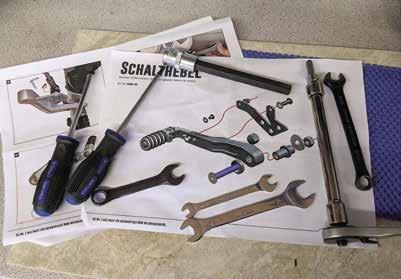
With everything in place, I climbed into the saddle with the bike on the centerstand, fired it up, snicked it into 1st gear and had a WTF moment as the engine immediately died. Restarted it again and it died again, this time with a “Traction Control” warning on the screen. My first panicked reaction was that I had found some fantastic new way to mess up a transmission, but after a minute of thought and several deep breaths, I suspected the “no-traction” error was because the rear wheel was spinning in the air. And that was confirmed (whew!) when I got both wheels down on the floor.
My testing completed, I did a final once-over of all fasteners–highly recommended for any project as critical as this, as it’s easy to miss something that wasn’t properly or completely tightened. I did a short test ride on a post-Christmas day, following that up on an unusually warm New Year’s Day with 100 miles on a group ride with the Cincinnati BMW club. No
missed shifts and the lever now sits exactly where my left foot expects to find it.
One thing I did notice and have now corrected is that the shiny stainless-steel segment that holds the spring that allows the lever to fold is slippery and the tip of my foot would slide around on it. Some friction tape fixed the problem.
The shifter tip besides folding, is a tick thicker and slightly longer than the stocker. Because the stock lever is tucked in very close to the frame (which no doubt explains why many riders complain of missed shifts), the Wunderlich has a bend that puts it more in line with the footpeg and further out from the frame. The more expansive shape and the option of being able to tailor its length to exactly match your boot size, whether it’s humongous or petite, is what makes this a must-have if you’re missing shifts regularly.
Suggested retail at wunderlichamerica.com is $219.99 which includes a 45-day return policy and one-year warranty. This adjustable lever fits all 2013-23 R 1200 GS models and 2014-23 R 1200/1250 GS and GS Adventure models.

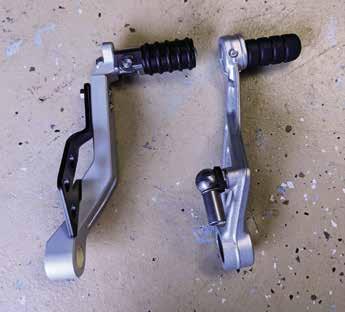 MARK THOMPSON #218859
MARK THOMPSON #218859
My splendid friend Orloff, the gentleman who gave me the R 51/3 a year or so back, recently sent me a link to a Hagerty (the insurer of old and classic vehicles) article about how a fellow figured out how to convert old Model A engines into industrialstrength compressors.
During the depths of the Depression, many folks got rather creative in making do. Around 1934, one of these fellows, Gordon Smith, figured out how to convert a Model A engine into a heavy-duty air compressor. Using a replacement head and several other bolt-on parts, he came up with a rig that used two cylinders for power and the other two cylinders for compressing air into a reservoir tank. He essentially cut off the front half of the car and rearranged things to create a trailer that could be easily pulled to a work site. He started a company (Gordon Smith and Company) in Ohio, which provided either parts or complete compressors up until 1968. There is a club, based in Kentucky, of folks interested in these compressors. They even have a detailed Facebook page, the Smith Motor Compressor Club.
The Hagerty article triggered a few letters back and forth to them, a couple of which discussed a much smaller-scaled version of the engine compression powered air pumps: the “EngineAir” device for pumping up vehicle tires. That, in turn, sent me into my shop to look through the “Bike Touring” drawer. I found a couple of my old EngineAir tire pumps, looking fairly clean, considering that I had used them a few times over the decades to mount new tires and repair flats. The tire pump even played a part in 1991 and my being labeled a hero as I aired up the flat tire of a stranded VW Microbus in the palm grove campground of Zipolite Beach, way down in southern Mexico. I had also used the pump several times, in Mexico, the U.S. and in a roundabout in central London. At some point, the “chuffer pump” got retired to my drawer of touring stuff, to be replaced by a new-fangled 12-volt air pump.
There were various versions of this tool, all of which called for removing a spark plug, screwing in the device and then running the engine at a fast idle, quickly pumping up a tire. I
actually have two of them, from different sources. Many people were concerned that this would send fuel vapor into the tire, but it ran with a piston that pulled air from the outside, not from inside the combustion chamber. I always dropped the carburetor bowl just to be sure. These show up on eBay, often for far more than $100. Aerostitch sold them for $30.
I had a pleasant exchange with Andy Goldfine, the founder of Aerostich as I gathered information about this device. Aerostich sold them up until the late 1960s. Andy said the EngineAir-type pumps fell out of favor for several reasons:
1. More and more bikes were being sold with deeply recessed sparkplugs, making it impossible to use the EngineAir (for instance, BMW Oilheads).
2.The low cost of the 12-volt air pumps - $11 at Walmart!
3. The ease of using the 12-volt air pump.
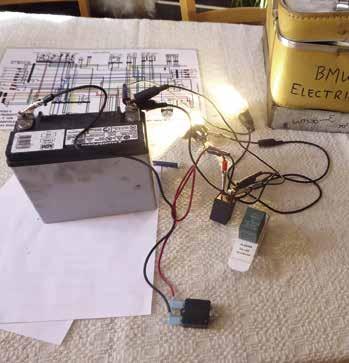
4. More riders, thanks to cell phones and other factors, are kind of far away from the notion that wrenching on their bikes is part of the deal.
5. Fewer flats occur due to improved (and tubeless!) tires.
This topic was discussed not too long ago on the Aerostich blog that Mr. Goldfine maintains, attached to his company’s website. Several of the blog pages were of real interest to this old airhead rider.
The actual laying of my hands on Airheads has slowed down for the winter. Other than a couple of shipped-in gearboxes, I just had one bike here, a 1988 R 100 RS with an electrical problem. It constantly blew fuses when turned on which told me the short-to-ground was somewhere “downstream” from the fuses. There are just two fuses. One covers the switched power circuits (green w/black stripe wire) and the other is mostly lighting (gray w/black stripe wire). The fuse that kept sacrificing itself was the switched power one. I installed my 10-amp circuit breaker to allow me to test the circuits under power. I wrote about this homemade electrical tool in January.
I started disconnecting various green w/black stripe circuits,
The test rig, set up to verify that the new turn signal flasher works as it should. It produced a steady flashing, as I wanted.The differences among the three varieties of three-prong turn signal flashers. Should you install an incorrect flasher in the bike, it won't work. I found all three types at superbrightleds.com, under "Flashers and load resistors." I also took the bad flasher to an auto parts store and matched it up.
either by pulling wires off connections or by unplugging relays that involved these circuits. I eventually found that the “blowing fuse problem” stopped when I pulled the turn-signal flasher relay.


While I had the relay out, I rigged up a test bed to see if it worked as it should. I lashed up a pair of old turn signal lights, a battery and the flasher with a few jumper wires. I quickly discovered that the bike’s flasher relay did not work at all. A test using a fresh relay showed the riggedup circuit worked as it should. It was about then that I noticed that not all three-prong flashers are the same. They all have three prongs, and the prongs are labeled the same for E/31 (ground), B/49 (power) and L/49a (load). The problem was in the fact that the prongs were arranged differently for various flashers.
I get my flashers from various online sources, and I didn’t have a replacement with the proper prong arrangement. So, I carried the non-working flasher to a car parts shop and compared it with what they were selling. I found a match ($17.00) and took it home to find out that it worked just fine. The bike now had working turn signals and no longer popped fuses. After a test ride of a few miles, I called the problem fixed. The lesson learned? There are three kinds of 3-prong flashers: American, European and Japanese.

Yesterday I received the proper tool for the next project—the servicing of a late /2 gearbox. After a couple of months of chasing around, I finally located the tool for pulling the flange off the output of a transmission. Unlike the 1970-on bikes, the earlier trannies have slightly “out of square” bolt holes on the flange, rendering the tool I like to use unworkable. I finally located what I was looking for (made in Europe), at Boxer2valve, located in North Carolina. They have a pretty extensive line of BMW tools. Considering that it is a nicely machined tool for 70-yearold BMW bikes, I was pleased to discover that it isn’t shockingly expensive.
Matt acquired his first BMW in 1972, upon his return from Vietnam. He hired on at Doc’s BMW of Colorado Springs in 1977. Since then, his life has been a mixture of travel, owning/working in various shops, as a nurse, and being very involved in his local community. He has owned around 15 Airhead BMWs over the years, but his first bike, a 1972 R 75/5, is parked by the front door with 423,000 miles on the odometer.
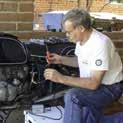 The two types of flashers used in the earlier airhead BMWs. The two-prong flasher is for the Slash 5 bikes. The three-prong plugs into some of the later Airheads. You can use these flashers in the Slash /6 and /7 bikes to replace the rather expensive flasher that residing in the headlight, but it takes a bit of wiring fabrication. The 1974 to 1980 flasher runs $102 at EuroMotoElectric, so using a $15 flasher with a bit of added wiring makes sense.
Two rather lightly used EngineAir type of tire pumps. A very simple device, they fully inflate a motorcycle tire in about a minute. I've helped out a couple of car drivers as well with flats in remote areas. Alas, they are no longer sold, other than on eBay, where they go for a lot more than what they cost new.
MATT PARKHOUSE #13272
The two types of flashers used in the earlier airhead BMWs. The two-prong flasher is for the Slash 5 bikes. The three-prong plugs into some of the later Airheads. You can use these flashers in the Slash /6 and /7 bikes to replace the rather expensive flasher that residing in the headlight, but it takes a bit of wiring fabrication. The 1974 to 1980 flasher runs $102 at EuroMotoElectric, so using a $15 flasher with a bit of added wiring makes sense.
Two rather lightly used EngineAir type of tire pumps. A very simple device, they fully inflate a motorcycle tire in about a minute. I've helped out a couple of car drivers as well with flats in remote areas. Alas, they are no longer sold, other than on eBay, where they go for a lot more than what they cost new.
MATT PARKHOUSE #13272


















INTELLIGENT MULTIFUNCTION LED LIGHTS FOR BMW BIKES



























SINGLE FUNCTION TURN SIGNALS






DUAL FUNCTION FRONT DRIVING LIGHTS/TURN SIGNALS



TRIPLE FUNCTION REAR RUNNING TURN SIGNALS
Hazard Lights



RUNNING/BRAKE LIGHTS/TURN
Running Lights

Brake Lights

Hazard Lights





Running Lights

































Brake Lights
VERY LATEST, HIGH INTENSITY OSRAM AUTOMOTIVE LED’S EMITTING CLASS LEADING 120 DEGREES OF VISIBLE LIGHT. (LENS DIFFUSED TO 180 DEGREES)







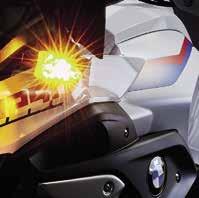





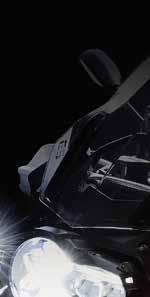
Weiser’s updated EVO range of LED lights add dynamic multi-functionality to your bike’s turn signals in a stunningly effective package. Designed to help get your motorcycle seen... whatever the maneuver...whatever the weather conditions.
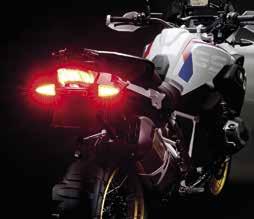


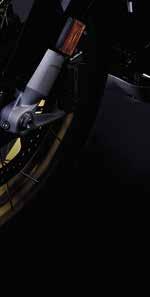



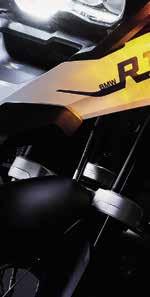

When people think cross-Canada road trip, their minds often go to the mountains of British Columbia and Alberta, to lobster festivals in the Maritimes while searching for Anne of Green Gables, or even to the rocky terrain of Newfoundland and Labrador where travellers can be confused by the accents and the 30-minute time zone. Cross-Canada road trip does not often bring excitement for the plains of Saskatchewan. Because you can drive across Saskatchewan along the Trans-Canada Highway in under 6.5 hours, most people consider it a gas and lunch stop, with maybe a quick overnighter. It can be considered a nuisance for those wanting to get to what they consider the more exciting parts of Canada. For Janel and I, however, we wanted to get to know the plains. We wanted to experience the seas of green fields that go on into the far horizon. What we didn’t expect was an exceptional adventure in this often-overlooked region of our home country.
“DUSTIN!” Janel shouted as the pothole-littered pavement suddenly turned to dirt.
I hadn’t even really noticed the change. The lack of corners and other vehicles along with the high stalks of corn surrounding this backroad in central Saskatchewan allowed my mind to wander a bit. For Janel, however, the sudden change in road condition had her slow down, which of course had her front tire try to take her where it wanted to go, rather than where she wanted to go. Unlike in British Columbia however, after shouting my name for what type of support she expected I can only imagine, she easily took control of the bike and kept herself upright and headed straight down the narrow road.
We had been in Saskatchewan for a couple hours on our way to Cypress Hills Interprovincial Park where we were going to spend some time hiking and enjoying a few days off the bikes. Staying true to our goal of avoiding the Trans-Canada as much as possible, we were riding some backroads that could likely have used a bit more upkeep. We rode past old decrepit farmhouses, through small

“The prairie skies can always make you see more than what you believe.”
~ Jackson Burnet, The Past Never Ends
dusty towns of fewer than 80 residents and enjoyed having the roads almost entirely to ourselves. As the day progressed and the sun started to set in the distant sky, we could see hundreds of pronghorns jumping through the fields at speeds we could only imagine. We only hoped the beautiful animals would stay on their side of the fences as we stayed on ours. The sky continued to darken and narrow treed forests began to trade places with the long running plains. We had begun our final approach into Cypress Hills and the start of our adventure through Saskatchewan.
After a couple of days hiking in Cypress Hills, we headed out to Regina. If you ask anyone from Saskatchewan who doesn’t live in Regina what they think about Regina, they will likely not have anything pleasant to say. One would get the feeling that it is almost in fashion to dislike Regina. However, our experience there was fantastic.
Our first stop in Regina was Platinum Recreation and Powersports where I wanted the mechanics there to give Janel’s bike a once over after her crash in British Columbia to make sure there were no additional issues I might have overlooked.
After getting the OK on Janel’s bike, we spent a couple to days exploring the city of Regina. Janel got excited every time we saw rabbits hopping around the beautiful 930-hectare Wascana Park. While there, I fattened myself up at Avenue, one of the best restaurants of our whole journey. We could not get over just how friendly everyone was–even an elderly woman we met on the sidewalk invited us into her home to ask us about our journey. Our last highlight in Regina came when we went to ride out of town and we noticed that most drivers there recognized the importance of paying attention for motorcycles. We didn’t have a single near-death experience as we rode north out of town. It was a stressfree drive, other than the fact we were headed straight into some very ominous clouds that looked to be foreshadowing a coming storm.
We knew a rainstorm was in the forecast for our ride to Manitou Beach (180 km/112 miles), so we left early in the day hoping to beat the rain and to soak

Hiking Cypress Hills.

in the natural hot springs the area is famous for. About 100 kms (62 miles) outside of the town, the dark cloudy sky made the landscapes around us look like the time was 9 p.m. and not 9 a.m. Janel started to voice her annoyance that this was the summer of rain in Canada. I knew she was tired of being wet and cold, so I got her to push hard to beat the rain to Manitou beach. As we arrived on the dirt roads that lead into town, the rain started to drizzle. In the five minutes it took us to find the Manitou Springs Resort, the rain went from a light drizzle to a torrential
The sky opened and started to flood the town of Manitou Beach. Lighting streaked across the sky, followed quickly by thunder that would shake the table in our hotel room. We watched the storm from the safety of our room, grateful we didn’t leave Regina as little as 10 minutes later that morning and were stuck riding in the sheets of rain coming down (not just due to being soggy, but also for safety concerns).
With the storm raging outside, we took our tired bodies for a soak in the indoor
An old deserted house.hot springs. The slightly tinted green water is loaded with magnesium, sulphate, carbonate and potassium, and these minerals are suggested to help relax the body, specifically joint and muscle pain. After two weeks on the road, and one crash under our belt, a body relaxing day was what the doctor called for. Wrapped in a noodle, we floated around in different temperature pools for the entirety of the afternoon and then enjoyed a nice dinner at the resort with a large slice of key lime pie for dessert–the best key lime pie we ever had.
The following morning, we saw the damage the storm had caused with pavement torn up by the rushing water, houses in the lowest part of town completely flooded and many of the dirt roads in town a mess of ruts and runoff. We made the decision to really put ourselves out as we waited for the road repairs and spent two additional days in the mineral baths and gorging ourselves on key lime pie before continuing our journey further north into the heart of Saskatchewan.
Our ride north to Candle Lake (275 km, 170 miles) was uneventful other than the fact it was not raining. The further north we got, the fewer and fewer cars we saw. Without the threat of rain on the horizon, and with the lack of traffic we were able to enjoy the road in peace and quiet, and we were warm! The final kilometer into the Candle Lake Golf resort was a dirt road. The heavy rains had done some damage to the road here as well, and as I pulled into the parking lot, I realized Janel was about 500 metres behind me, slowly bouncing through the holes. I thought to myself, “We are really going to need some practice before we hit the dirt highway Route 389 in Quebec…”
Once Janel finally made it to the resort, we checked in and the owners gave us a golf cart to go explore. I won’t lie, the mosquitos where the size of small birds, but as long as we kept moving in the cart, they stayed away. As we aren’t golfers, we spent the next day exploring the area around the lake with our trusted steed (the golf cart) and again, eating lots of good food. Ride and eat, what more could we ask for?

 Above, Getting the bikes checked. Below, Our bartender in Regina.
Above, Getting the bikes checked. Below, Our bartender in Regina.
On our last evening at the resort, I started looking up our route to Manitoba. We had two choices, we could head further north to the town of Flin Flon, which would allow us to drive south to The Pas (yes, these are all real names) through tons of lakes that northern Manitoba is famous for, or we could take a straight shot east to The Pas. The weather was looking good again so, I suggested to Janel we take the northern route, and she seemed open to it. I dug further into what highways we would be taking and when I typed in “Highway 120,” Google told me it was a paved road, however, an image suggested otherwise.
I investigated further, but all I could find was information saying the road was paved. I made the assumption the image was old and wrapped up planning our route into northern Saskatchewan and Manitoba.

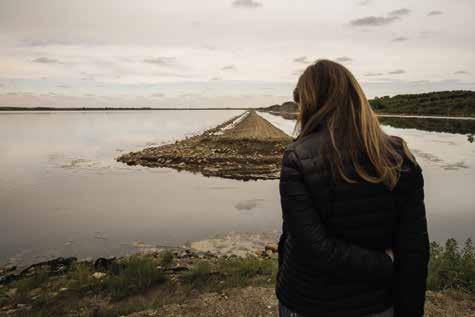
On the morning of our departure, we packed up the bikes in the rising sun. It was a pleasant experience: our backs were warm, our bellies were full, and we were off on another adventure. I had given Janel some advice for the one-kilometer dirt road out of the resort, and she seemed to be doing really well at keeping up with me. We made a turn onto Highway 120 and were off to
After about 30 minutes of driving, the road turned to dirt. It wasn’t a horrible dirt road, as the rain had moistened the road enough to keep the dust down, but it was well rutted and full of tracks. We pulled over after about 500 meters realizing this was going to go on for a while.
“Did you know it was going to be like this!?” Janel asked.
“No, it said it was paved,” I responded.
“Uh huh…”
At that point, trying to decide if we should turn back or not, a car came trudging down the road. I got the driver to stop and asked how long the road was dirt: “Ahh, about 65 kilometers,” he said. I thought to myself, “well that is it, I better grab Janel and tell her we should turn around.” I pulled up beside her and told her the news. I suggested we just go back and take the southern route, however, she wanted to keep going.
“I need to learn to do this for Quebec and Labrador, let’s keep going,” she said.
I was shocked, excited, and proud of her. With that, we set off down the 65-kilometer (40 mile) dirt highway. As we rode, I gave Janel advice about following my track, staying out of ruts, keeping her eyes forward, and trusting the bike to go straight. At one point she suggested to me that I was aware the road was dirt prior to our arrival, but in all honestly, I really believed it was paved. Did I think there was a chance it was dirt? In a simple answer, yes. I might have held back the on informing her of that.
The first half of the road was decent: the ruts were avoidable, there wasn’t any traffic, and Janel was doing well at keeping a pace of about 60 km/hr. The trees hugged the road tightly, and as it was still early morning the sun was just cresting over the trees creating a surreal light that made us feel like we were adventurers. The second half, however, was very different. The trees opened up into a barren landscape and the road turned ugly. It looked as though large trucks had driven over this section during the rainstorm when the road was flooded. The ruts were deep, bumpy, and pulled the bikes all over the road. For safety, I got Janel to slow down (which wasn’t all that difficult), we started being
The road's end in Manitoba.very selective on which tracks we picked, and we kept our eyes peeled for animals and other vehicles. Only one truck passed us, and they stayed far to the left to leave us lots of room. I am sure Janel was white knuckling it a bit, but in the end, she did just fine.
After a little over an hour, we reached pavement. I haven’t been that proud of Janel in a long time. I don’t think she had been that proud of herself in a long time. She really had this idea in her head what dirt riding would be and was very afraid of it. I kept trying to get her to try some dirt roads before the trip, but she was so nervous, so it just never happened. But once she was forced to ride off-road for an extended period, she killed it. Confident, careful, and calm. A long way from screaming “DUSTIN!” on her previous dirt ride.
Next month we head to Manitoba to explore thermal spas, Vikings, and bugs. Oh, the bugs.
If you want to see our ride through Saskatchewan visit youtube.com/@ lostingear/videos.
The first interprovincial park in Canada, the Cypress Hills Interprovincial Park is a lush forest in southern Saskatchewan. There are dozens of hikes you can do in the area, and on the two we did, we didn’t run into another person. It was a perfect couple of days of relaxation. The park offers several campgrounds, but also has The Resort at Cypress which is where we stayed. We had a townhouse for our visit that had a great view of the park. The restaurant is delicious and inexpensive as well. resortatcypresshills.ca

As mentioned, Regina is worth the visit. There are several great things to see and do.
The largest T-Rex ever found (Scotty) is located in the Royal Saskatchewan Museum right by Entrance by donation royalsaskmuseum.ca/trex
Wascana Park has a beautiful man-made lake, and it makes for a great walk past the provincial parliament. Do not miss out on a meal at Avenue restaurant. Easily one of the best meals we had the whole trip. We ordered some martinis, and the bartender brings a cart to your table to make them in front of you. A great experience and delicious meal. avenuerestaurantandbar.com
The best place to stay in town is Hotel Saskatchewan. It is a beautiful, centrally located hotel built in 1927. There is a lot of history here, and the views from the higher floors are fantastic. They also have patrolled parking for the important things. marriott.com
Dustin grew up in Quesnel, British Columbia, and began riding on the back of his father's motorcycle many years ago. He has a doctorate of Community Health with a speciality in Indigenous health. He currently works several contract positions with Indigenous organizations across Canada. Dustin's publication credits include The Globe and Mail, CBC, and Vice News, along with several extreme sport magazines such as Explore, Sidetracked, Canoe and Kayak, and Paddle Magazine.

Dustin and Janel currently live in Powell River, British Columbia.
Really, you come here either for the beach (in a rainstorm, maybe not…) and for the spa. Your best option is to stay at the Manitou Springs Resort, as the hot springs are located inside and you gain unlimited free access if you stay here. Ask for a corner room so you can enjoy the views over the lake. Lastly, try the desserts in the restaurant, I promise you will not be disappointed. manitousprings.ca
If you like to golf, the Candle Lake Golf is a great place to stay. Even if you don’t golf, the resort is right off the main highway and has water access and rooms ranging from full cottages to newly renovated hotel rooms. It is a very popular place for weddings, so be sure to book ahead. We really enjoyed cruising around the area in a golf cart and checking out the areas around the lake. The owner even let me take my motorcycle around the golf cart track which was a riot. candlelakegolfresort.com
A long time coming;
 BY OWEN BOWER #226178
BY OWEN BOWER #226178

The miles passed slowly along the two-lane county roads at about 60 miles an hour with an upright, neutral position. Rolling off the throttle as I entered the town of Doland, South Dakota, my mind wandered. “I wonder how far away I must be from the nearest spark plug for this machine?”
I left my parents’ house in Duluth the day before. It was a sunny morning, and Lake Superior was calm and peaceful. My nerves were not. I was about to take a 20-year-old motorcycle out of a barn and push it down the road for 1,800 miles to northern Idaho, where my wife and daughter were vacationing. The gravity of that decision was weighing on me heavily as I spent the last hour with my parents drinking coffee and making small talk. My mind rolled over all the things I hadn’t done to ensure a successful journey. As we hugged and said our goodbyes, I knew what I was setting out to do was risky and had been a long time coming.
I grew up around motorcycles and learned to ride at a young age, although I would not own my first motorcycle until I was 21. The excitement and freedom this simple machine brought to my life is difficult to describe to those who don’t ride; it needs no explanation for those who do.
My family had relocated from Northern Minnesota, to Cincinnati, Ohio, when I was 11 and I bought my first motorcycle as a sophomore studying engineering at the University of Cincinnati, a purple 1996 Kawasaki ZX600E.
A common interest in motorcycles introduced me to Don and Dean, two other students in the engineering program at UC. Having more brains than money at the time, the three of us started MotoUC–the university’s only motorcycle-focused student club. MotoUC was open to all and membership was free. We held regular club meetings that happened to coincide with the MotoGP broadcast and made frequent “field trips” to AMA races. We even made Daytona Beach Bike Week one year. The costs associated with our club were reimbursed by the university, paid from student fees collected from tuitions. I am confident that our personal return on investment for student fees was better than anyone else attending at that time.
Between studies, working part time, and my responsibilities as MotoUC president, I was stretched thin. Even though I was a local during college, it was rare to find the time to ride much with my dad, who lived a few miles away in Bridgetown. Occasionally, we’d hit the Western Hills twisties, like Devil’s Backbone, or scope out the “hollers” in nearby Indiana and Northern Kentucky, but not often or for very long distances.
But the thought of long-distance riding has always been appealing to me, even if my schedule and equipment did not support the endeavor. After graduation I moved to the Pacific Northwest and have been focused on my career and starting a family, rarely having time to myself. Between work and family obligations, it was hard to find enough time to cover any meaningful distance. When I can ride for pleasure, it feels selfish. For years my motorcycling has been confined to the I-5 corridor and my daily commute to Seattle from Tacoma. While I still would rather ride and take advantage of the HOV lane than drive, the Interstate at rush hour is not the open road.
My formative years were spent in Duluth, Minnesota, around my mom’s side of the family. Around the time I moved to
Tacoma, my parents and two younger sisters relocated from Cincinnati back to Duluth. In the Covid-crazy fall of 2020 my grandmother’s health took a turn for the worse. Mom said I should come home and visit soon if I could. I’m glad I did. Grandma Jean passed away in the spring of 2021. Her funeral was like a big family reunion. During this time I realized how my parents had aged since we all left Cincinnati. In his late 60s now, Dad was not as capable as I’d remembered, and the chance for us to ride together was passing. The desire to make up for lost time became pressing for me.
Naturally I did what anyone else would do and bought a 2002 BMW R 1100 S sight unseen off the Twin Cities’ Craigslist. I had a buddy in Minneapolis keep it in his garage for three months until I could fly back to Minneapolis and ride it 150 miles up to Duluth. My plan was to ride around northern Minnesota with dad for a week, finally getting to do what I had wanted to so many years ago.
Dad had restored a 1968 Honda CB 350 a few years before and loved scooting that thing around town. It seemed like the perfect plan: day trips up Bob Dylan’s fabled Highway 61, tooling around Duluth to see the places I knew from my childhood, exploring areas I’d never gotten to.
But it wasn’t to be. The stress of working a hospital job during the Covid epidemic had seriously affected Dad’s health. Unknown to anyone, his heart had been in atrial fibrillation for weeks by the time I arrived and when we took a couple of short trips around town, I could tell something was seriously wrong with him.
On our first trip, an hour-long ride up the shore, he was whipped. When we stopped for ice cream in Two Harbors, he was dizzy and short of breath. I thought maybe his blood sugar was low, but his heart rhythm wasn’t pumping blood to his brain. Sitting there eating our ice cream, I ran scenarios on how we’d get both motorcycles home if we needed to call an ambulance.
Shortly after my visit, Dad was hospitalized with a heart rate in the 170s, and they had to stop his heart to get it stabilized. Apparently, such episodes are fairly common with age, often brought on by stress, overuse of stimulants or doing questionable things like riding motorcycles. I am grateful to say that he has since made a full recovery and plans to get a cruiser yet before it’s too late. Over the final few days of that trip, I rode around Duluth alone and saw many of the things I’d wanted to on that trip, saddened to miss the big ride I never got with my dad.
My longest ride of that trip was along the shore up Hwy 61 to Grand Portage. Riding solitaire is both lonely and therapeutic. It seems no matter how hard I try to focus my thoughts, without the camaraderie and distraction of friends on a ride, my mind wanders into vague, subconscious anxieties, issues buried down deep. Given enough space and time, however, the solutions to these problems I don’t even know exist will present themselves.
The out and back trip took the better part of the day. By the time I pulled into Sir Benedict’s Tavern near my folk’s turn of the century row house in Duluth, I was taken with the R 1100 S. As I sat enjoying a Bells Two-Hearted I realized there wasn’t
anything specific about the bike that impressed me, it just did everything well. Initially, I had thought I’d either sell it to Dad or have him sell it for me after our trip. But the bike had grown on me, and I didn’t want to part with it.
My Uncle John owned a big barn a half-block up the avenue from Dad’s–a two-story structure on the hillside full of implements and pigeons that once served as the Duluth Police Horse Livery. I could park it there rent-free on a battery tender under a bike cover (you know, pigeons) after running some fuel stabilizer through it. That bought me some time. Selling it then in late summer or fall wouldn’t fetch the best price or so I told the wife.
“Dad and I are selling the house and moving to Arizona,” Mom announced!
I couldn’t really blame them. All of us kids had left Duluth. My younger brother lived in Ann Arbor, and my two sisters in Tucson and Nashville. I lived on the same latitude but a 24-hour drive away in Washington. Had my parents grown tired of traveling anytime they wanted to see grandkids, or were they tired of shoveling snow for six months out of the year? Regardless, they were putting the house on the market, and I now had a deadline to retrieve the BMW.
I’d put around 500 miles on the machine between the ride from Minneapolis to Duluth and riding around northern

Minnesota, enough to convince me it was reliable. And with only 30k miles on the clock, I knew the BMW had plenty of life left in it.
The previous owner had just serviced the final drive, air filter and oil before I bought it off Craigslist. During the ridable months the bike sat in the barn, Dad had taken it out on the road a few times “to keep it fresh.”
I decided to pretend I didn’t see the date code on the tires and put some fresh 15-W50 AMSOIL in the crankcase before a shakedown run back up Hwy 61–one last trip up the shore. Saying goodbye to the lake was harder than I thought it would be.
I left Duluth on a Sunday morning around 10 a.m., destination Watertown, South Dakota. I was both excited and anxious, so much so that breathing exercises were employed to help calm myself and avoid my own tachycardia. Recently, on The Ride Inside, Mark Barnes made mention of this technique in his essay on dealing with stress. If I had known about his other recommendations for dealing with stress, I would have likely employed those as well.
I considered running with GPS on this trip but decided on navigating as I did as a younger man. Old School without the modern conveniences of smart phones, just getting to the next town, then checking the route to see which way to go next. My
dad’s side of the family is from west central Minnesota so a late lunch in Wilmar was a must. My goal was to avoid the interstate as much as possible and travel the two-lane highways wherever I could.
From the barn I traveled south on a mostly smooth Hwy 23. Leaving Duluth, this route sneaks you through northwestern Wisconsin but only for about 1,000 feet or so before crossing back into Minnesota. You snake uphill through Jay Cooke State Park and the canyons rimming Lake Superior. I felt I had the entire county to myself. After a few hours, the landscape smooths and softens as you leave the northwoods and descend into marshlands and rocky, hardscrabble farms of alfalfa and beets.
Having run a tank full of miles on two-lane roads, my stress was all but gone. Instead, my mind was free to focus on the road, the landscape of fields and rusting infrastructure, and not think too much about tires old enough to be learning trigonometry.
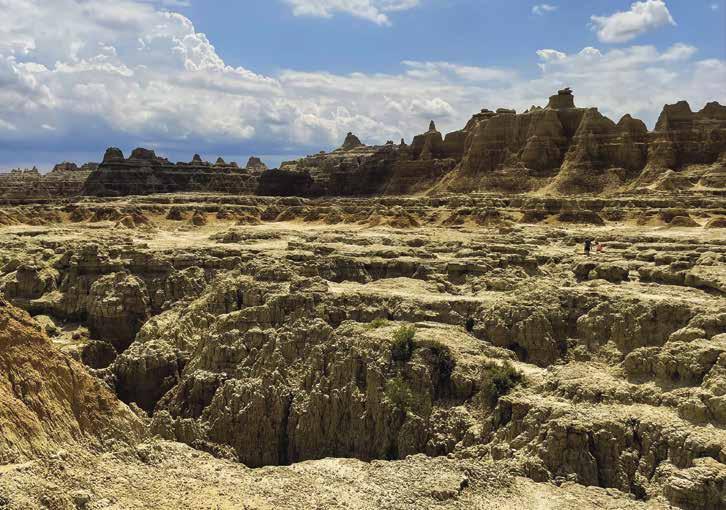
After crossing the Mississippi River at St. Cloud, the rolling hills of central Minnesota from Cold Spring to New London were peaceful and reminded me of traveling these roads in my folk’s Oldsmobile as a kid some 30 years before. I had lunch with my aunts, uncle and cousins at Applebee’s on the edge of Wilmar where the gravelly glacial moraine flattens down for a hundredmile stretch of two-foot-deep black soil with soybeans and corn
and turkey barns baking in the summer sun. It occurred to me it had probably been 20 years since I’d been to these parts, and I wondered if I would ever make time to get back here again.
I left Hwy 23 at Clara City, Minnesota, and took Hwy 7 West to Montevideo. I remember as a kid thinking that city must be something like Hollywood with a name like that. It is not. Crossing over the Minnesota river in Montevideo provided the last curves I’d see for several hundred miles. Once on Hwy 212 west, the level farmland stretched on forever. Straight and flat, without distraction, freeing my mind to wander and work through solutions to problems I didn’t even know about. As I arrived in Watertown, South Dakota, that evening, I witnessed one of the most stunning sunsets I’ve ever seen. While I didn’t explore much of the town, I’ll never forget that sunset and the sense of accomplishment from that first long day on the road.
Leaving near dawn the following morning it was evident I had not packed enough cool weather gear to compensate for the wind chill on the bike. What’s worse, the radar showed showers from Watertown to Pierre, South Dakota. I had spent most of the previous day traveling at 60 mph and the bike seemed happy. Now I was in a full tuck to get out of the wind to keep the shivering to a mild tremor. Luckily, Hwy 212 was just outside the reach of the jet-stream that carried black clouds of rain to the south of me. If I had chosen to use I-90 instead of running this less traveled, more rural two-lane highway, I’d have been soaked.
After a brief rest in Pierre, I was back on the road, jamming west on Hwy 14. Pronounced “Pier,” the state capitol is larger than I expected and the amount of water in the Missouri River reservoir is unbelievable. Still farmland for the most part, the hills west of there have a decidedly different feeling from the flat farmland of west central Minnesota and eastern South Dakota. Leaving the city, it felt as if I was back in the high plains desert of eastern Washington.
Once the threat of rain lifted, the sun began to make my choice of riding gear feel intentional. I had been lucky up to this point in finding my way along the route by remembering what towns would set the new heading. I only had one oversight earlier in the day that put me a few minutes past my turn. My overall approach to navigating was designed–as a priority–to leave my mind focused on the ride, the experience, the immediate, precious and unrepeatable present.
When I reached the Badlands early that Monday afternoon, I swear I saw more people in the park there than I had seen in the entire state of South Dakota to that point. The wind-carved, colorfully striated, water-eroded landscape of the western Dakotas is an amazing and mesmerizing geologically oddity. But I couldn’t stay long for photos. I took the quicker route of Hwy 44 and travelled alongside the park towards Mount Rushmore.
I had two must-do bucket list items on the itinerary: Mt
Rushmore and Devils Tower. Everything else would be nice to pass by, those were a must. Approaching Rapid City, the landscape again changed wildly back to feeling like the north woods again. The perfume of Ponderosa and Douglas Fir will remind you why you chose to ride exposed to the elements in the first place. The slightly less-crowded forest here is different from northern Minnesota, but in general the Black Hills were just as I imagined they would be. Arid, hot, replete with trees and thick with tourists. I had been spoiled up to this point, spared any real traffic for half the distance of a Time Zone. Hwy 16 changed that.

Arriving at Mount Rushmore, it felt good to swap out my riding gear for street shoes and a Harley Davidson tee shirt and go walking about the monument. I would have spent more time there if I had been sharing the experience with others. Alone, however, I was able to make good time enjoying just what I wanted from the monument and interpretive trail. I had been looking forward all day to getting on Hwy 385 and its hour of delightful twisties to thread my way up to Lead and Deadwood. I really enjoyed the time I spent riding there and recommend it to all.
Of course, no self-respecting motorcyclist could be so close without stopping at Sturgis. So, Tuesday morning on my way out of town I made the pilgrimage of sorts to experience Motorcycle Mecca for myself. It turns out that at 7 a.m., Sturgis isn’t really
rocking. I figure I’ll have to return one day to fully experience the rally and stay nearby, if possible, to take the time to soak it all in.
South Dakota 34 changes to Wyoming 24 without any pomp or circumstance. Again, the cool mountain air with intermittent showers proved problematic for the mesh riding jacket I had foolishly thought would be perfect for this trip. In my defense, I would have brought more gear, but was limited to a carry-on bag on the flight to Duluth. That said, I am still impressed in my ability to fit a full-face helmet, riding boots, jacket, gloves, toiletries and clothes for a week-long trip in that carry-on bag.
The rains in northeastern Wyoming were light and sporadic, like the showers I am used to on my commute to and from Seattle. The two-hour ride from Sturgis to Devils Tower was one of the most enjoyable of my life. The two-lane wove through forest, following streambeds passing quaint homesteads–hypnotically, gently sweeping from side to side. The BMW responded effortlessly and felt anatomically attached to me. That ride was a lullaby.
As I was getting closer to Devils Tower the rain began to get worse, and again, the limitations of my riding gear became evident. I had been considering buying a sweatshirt or jacket to put under my mesh gear, but I was hours away from the nearest store that didn’t also sell gasoline and beef jerky, so I simply toughed it out. The ride from Sturgis to Devils Tower was worth all the discomfort of the wet ride that followed. I spent some time at the monument, taking in the majesty of that volcanic anomaly, and if it had not been for the rain, I would have stayed longer. I will be going back with friends or family again one day.
Unfortunately, my scheduled leave from family duties was coming to an end and I had planned to cover a lot of ground between now and settling in for the night in Three Forks, Montana. The rain in Wyoming gave way to heat and sun in Montana later in the day. While I had been travelling the back roads at a leisurely 60 mph, now on the interstate highway I was pushing 80 to 90 just keeping up with traffic. During this time my only real excitement seemed to arise from nearly running out of gas on the Crow Reservation in eastern Montana, and alternating between full tuck, partial tuck and no tuck to see how it affected fuel mileage between fill-ups.
When I reached my hotel in Three Forks, I was gratified to find my arrival coincided with the grand opening for Bridger Brewing. After a shower, I walked to the beautiful new building, and sat at the bar next to one of their employees from a sister location in Bozeman. A friendly bloke, probably in his early 30s, he was there to help with quality control for the new location. In addition to tasting many of the fine IPAs on tap, I was treated to a parade of food as the kitchen busily practiced menu preparation for his review. As I walked back to my hotel, I wondered how I could get a job like that. I slept well that night.
Wednesday morning was cold. Instead of the tolerable 60 mph chilly dawn on the two-lane, I was blasting 80 mph at 6 a.m. and cutting scratches in the tank with my nipples as I crossed over Pipestone Pass and the Continental Divide. I had an hour of riding on I-90 to put behind me before the destination of Montana Hwy 1 at Anaconda.
As luck would have it, to this point in the trip each time the odometer rolled over another 100 mile increment I serendipitously seemed to notice it while it happened. This was complete happenstance, but the fact that I had witnessed each rollover to this point became something of a game for me, seeing if I could keep the streak alive. Rolling into Anaconda that morning, shivering from cold and looking for non-ethanol fuel and coffee to treat myself and the BMW, I saw I’d missed the first rollover by less than a mile. I groaned at the oversight and then laughed hard in my helmet. I realized I was truly having fun.
Montana Hwy 1 is about 60 miles long and bypasses I-90 via Georgetown Lake and Philipsburg. I had read that this was the best road in Montana and had put this on the itinerary for that reason alone. It did not disappoint.
I was into the mountain section early, barely held up by any traffic. The road surface was surprisingly well kept for being somewhat of a mountain pass, considering the plows and heavy equipment needed to keep it open year-round. The cold is easier to bear when you are grinning from ear to ear.
After a brief blast down I-90 toward Missoula, I took Hwy 93, then 200 towards the Idaho panhandle. I’d traveled about 1,500 miles to this point but had not felt concerned about wildlife. It occurred to me that Hwy 200 just had to be crawling with deer, but I never saw one. The miles passed quickly as small mountain towns all along the route flickered by. I found myself wondering what people must do to make a living up here. The older I get, the more distance I want to the general population of our republic. All those spartan homesteads and rustic cabins found along my travels in northwestern Montana and the panhandle of Idaho feel just right to me. Maybe in retirement I could be content to live that far out.
Now that I was once again on the backroads, my pace slowed. After several days in the saddle the miles passed easily, the scenery changed gradually. As I got closer to Sandpoint, Idaho, where I was to meet up with my wife, daughter, and in-laws, I reflected on the 1,800 miles I had covered through the backroads and less-traveled byways of Minnesota, South Dakota, Wyoming, Montana, and Idaho. I was excited to see my family but at the same time sad that this trip was ending.
Since the trip last summer, my friends and family have had many questions, but they always ask what my favorite part was. At first it was difficult to say, but now I simply tell them it was the sheer length of the trip. Just being out in the world and moving through the country without any deadlines helped me find a rare peace, experiencing hundreds of miles through different landscapes on a machine that did everything I asked of it was rewarding.
In the months following my trip, I find myself thinking about the next long trip I can put together and when I can make that happen. Motorcycling is a sport that has brought so much joy and satisfaction to my life. I’ve been bitten by the touring bug. I’m determined to make time now, while I’m relatively young and healthy enough to enjoy long distance riding both solo and with other riders as well. I’ve been looking into trips to Crater Lake, down the Pacific Coast Highway, and the Grand Canyon as options to scratch the touring itch. I don’t know yet where or when the next trip will be, but one thing is certain, I am sure as hell going to bring a warmer jacket on the next one.




Riding your motorcycle is an exciting and gratifying escape from our crazy, busy world. My 83-year-old friend says riding bikes is the most fun you can have with your pants on. Riding with good friends certainly enhances this sport and adds to each rider’s safety by adding mutual support in the event of mechanical trouble, navigation issues and accident response. There’s nothing like sharing a cool beverage by a campfire or at the hotel bar after a safe, fun, day’s ride.
We know that motorcycle riding is more dangerous than driving an automobile. We compensate for this by being hyper vigilant and riding like we are in stealth mode. (i.e., The other drivers can’t see us.) We ride sober, obey traffic rules and wear all the gear all the time (ATGATT). These practices serve us well when riding solo. What about riding in groups? Do you know the riding abilities of each rider? I believe the biggest threat to group riding safety is from other riders within the group. I say that with experience as I’ve been hit from behind by fellow riders several times.
I spent a career flying fighters in the US Air Force, and I’ve found that group motorcycle riding relates quite closely to what I learned about formation flying. The USAF has strict rules about formation flying that were written in blood as the result of aircraft accidents. In the fighter community, there is never a valid excuse for hitting your flight leader or any aircraft in your formation. I say the same thing applies in motorcycle group riding. I’m going to share some of these formation flying rules that relate to group riding. These are rules for smaller groups (six or less).
1. Don’t hit the rider in front of you
2. Be in proper riding formation (see formation section)
3. Keep the rider in front of you in sight (unless waiting for the rider behind you)

4. Keep the rider in back of you in sight (stop and wait if necessary)
5. Pass back road warnings and hand signals
6. Ride within your own ability (i.e., no closer or faster than you feel comfortable)
Street: The formations need to be tight so that cars will treat us as a single entity and not try to horn in between us. Conversely, we need to stay far enough apart so that we have maneuver room and adequate reaction time. In fighter aviation terms, “Always leave yourself an out.” Riding too close requires concentration and doesn’t allow you enough brain processing power to scan the road for hazards or enough reaction time for those sudden stops. For example, in the 1970s, the USAF Thunderbird team was so concentrated on flying close fingertip formation that when the leader had a flight control issue and hit the ground, they all did as well.
Here is what the Motorcycle Safety Foundation recommends as standard formation positions:
Curvy mountainous roads: Single file with a minimum of two seconds spacing between riders. Try to keep the spacing betweeen two to three seconds so the leader isn’t trying to keep someone in sight in his mirror who is a mile behind. Momentary deviations from this two to three second interval are fine but get back into position quickly.
Straight roads: Staggered formation with the leader and odd numbered riders in the left 1/3 of the lane. Even number riders in the right 1/3 of the lane. Stay one second minimum behind the rider staggered in front of you and two seconds minimum behind the rider directly in front of you. The offset will allow you a clear path if the rider in front of you slams on his brakes. Momentary deviations from this one to two second interval are fine but get back into position quickly.
Stop Signs, Stoplights: Close the gap up but leave nose/tail clearance unless the rider in front of you asks you to pull up to line abreast. Bikes are unstable when stopped and have been know to fall over into each other. Never ride to a screaching halt line abreast with the rider in front of you. Never pass the taillight of the preceeding rider withtout his knowledge or consent.
My Recommendations For Offroading/Dirt roads: Follow in single file at an interval that easily allows you to keep the rider in front of you in sight, allows you adequate stopping distance (dust can drop visibility to near zero quite suddenly) and minimizes dust inhalation. Dualsport and adventure bikes accelerate awesomely but don’t stop worth a damn on dirt.
Formation Leader: Briefs the route, assigns rider position numbers and expected formations. Decides where to stop. Passes back proper hand signals (see the standard handsignals below). Rides in a predictable manner that allows the slowest rider to keep up. Keeps track of all riders. Is responsible for the safety of the group. Takes inputs from all riders when possible before deciding the best course of action.
Leader Priorities (in order):
1. Group safety
2. Navigation
Middle Riders: Stay in proper assigned formation position (not too close and not too far back). Don’t switch positions willy-nilly as the leader may have assigned you your position for a reason. Help warn all riders of safety issues. Keep rider behind you in sight. Stop and wait for him if necessary, especially if you are making a route turn.
Middle riders priorities (in order):
1. Don’t hit the rider in front of you.
2. Stay in proper riding formation.
3. Pass along safety warnings and hand signals.
4. Keep sight of the rider behind you.
5. Keep the rider in front of you in sight.
6. Back up the leader on navigation.
Sweep Rider: You’re the clean up guy. If you observe anything that’s a possible concern to the leader or group, inform the leader. Stop and help anyone who has stopped. Call the Leader and let him know what’s going on.
Sweep rider priorities (in order):
1. Don’t hit the rider in front of you.
2. Stay in proper riding formation.
3. Pass the leader safety information.
4. Keep the rider in front of you in sight.
5. Back up leader on navigation.
The fundamental thing in group riding is to stick together and take care of each other. The group will not abandon a rider, and riders should not leave the group without informing the leader. Like the Three Musketeers, it’s all for one and one for all!
Cardo and Sena make really good communication devices. They make riding safer and really add to the fun factor. For around $250 you can equip your helmet with rider-to-rider communication, Bluetooth enabled music, phone service, and voice enabled GPS directions. A nice communications system is one of the best farkles you can buy.

1. Show up for the ride on time.
2. Be ready to ride. Make sure your bike is fueled, tires inflated and maintenance items taken care of.
3. Stick with the group. We ride together for mutual support. Don’t take off on your own without informing the group leader. He’s responsible for accounting for all group members at the end of the ride.
4. Don’t endanger your group members with careless riding.
5. Ride in the proper position. Don’t be the lazy rider who falls way behind and don’t be the aggressive rider who tailgates.
6. In the fighter community, being a smart wingman who maintains situational awareness is highly valued. Be the smart rider. Anticipate and be prepared for passing zones, yellow lights, sudden stops, etc.
7. Allow adequate space between bikes when parking.
8. Don’t be the rider who makes everyone wait an additional five minutes after every break.
The bottom line is that we ride together for fun and mutual support. Make the ride fun for everyone by being responsible and upholding your end of the group riding contracts.

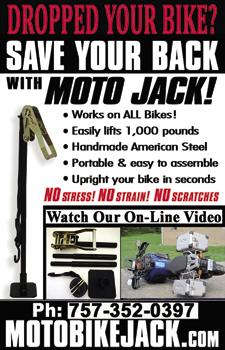
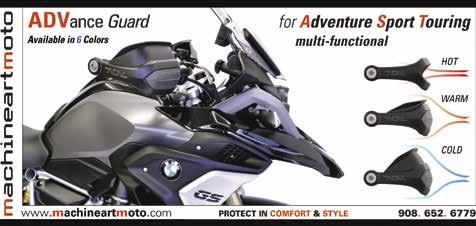

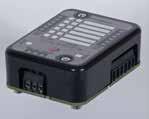


In our continuing efforts to bring innovative products and services to our membership, the MOA is excited to offer The Lifestyle Collection. For the first time, the MOA and Klim are offering co-branded apparel. Klim is the global leader in designing, developing and manufacturing, the most advanced technical riding gear and motor sports apparel for motorcycle riders. Happy shopping!


Apparently, the cook in my family disapproves of the turkey baster being used to extract fork oil, so I jumped on my XT600 to run into town for a new baster the day before Thanksgiving.
It was cold and I was already dressed in jeans, a heavy Carhartt jacket, coldweather work gloves and boots, so I just grabbed my helmet and off I went, relatively unprotected in terms of modern body armor but warm enough for the short jaunt on dirt and paved roads.
Three days prior I had been in Long Beach, California, on stage at the International Motorcycle Show with Kyle Wyman talking about how Yamaha Champions Riding School teaches riding. One technique we spend considerable time on is covering the front brake lever while cruising at partial throttle settings.
My belief is that riders should learn to “roll off the throttle to the brake lever,” not close the throttle and then reach to the brake lever. In crowded environments riders should train themselves to cover

the brake lever to reduce the time it takes to put the brake pads against the rotors. Cover the rear brake, too.
On stage, we discussed the time and distance it takes to unwrap your fingers from the throttle grip and reach to the brake lever. Last year Kyle Wyman had real-world input as he was hired by Roadracing World magazine to do some street riding, including splitting lanes in California. Suddenly, covering the brake lever at partial throttle settings made perfect sense to this young roadracer as
theory became reality.


As we stood up there and explained our viewpoint, we talked about approaching a crowded intersection or riding on a packed freeway or down your street during rush hour with your fingers poised over the front brake lever, your foot poised over the rear brake pedal. It’s an important subject because some new rider classes teach just the opposite, to not cover the brake. We disagree and believe all riders should cover the brakes. This isn’t another treatise on covering the brakes, this is an example of the real world making a good attempt on my physical well-being as I rode home on my XT with a turkey baster in my jacket pocket.
I was riding carefully on the dirt road close to my house because in 1996 I collided with a deer on Upper Big Tuhunga road at about the same hour. Deer begin moving around as dusk settles, and I had already seen a dead deer on this same road just a month ago. I was being pretty mellow, shivering a little and looking at the flock of wild turkeys to the east of the road. As I looked from the turkeys to the upcoming blind left-hand corner, a deer broke from behind the tree lining the road, directly into my path.
Yes, I was covering the brakes and went to them both. In seemingly slow motion, the forks of the XT dove as the tire bit into the hard-packed dirt and the rear of the sprinting deer slid past my front fender close enough to touch–the collision avoided by mere inches. I would have hit the deer if I was in a car or truck or moving a bit quicker or if I had taken longer to get the brakes on. It was close, but “almost crashing” is okay in our sport.
My message here is clear: Cover the brakes. Remember, it isn’t just how well you can stop your bike, it’s also how long it takes to initiate braking. You can practice emergency braking all you want, but if you need to unwrap your fingers from the throttle grip and reach to the brake lever, that could be a quarter of a second. At 60 mph, that quarter of a second will be 22 feet before your brake pads touch your brake rotors. At 30 mph, unwrapping my fingers from the throttle and reaching for the front brake would have cost me 11 feet. I would have hit the sprinting deer, and she was a big one.
There’s another thing you must not only practice, but become totally aware of. Never grab the brakes, even in an emergency. At Yamaha Champions Riding School we tell our students, “The emergency can shock you, but you can’t let that shock travel to your braking hand and foot.”

Each rider at our school gets shocked and surprised and begins this awareness. As we progress, we see our riders controlling that panic grab, being shocked but not stabbing the brake lever. They take this awareness into the real world, the world of deer and left-turning drivers and surprise lane changes and gravel patches.
On this day before Thanksgiving, that theoretical discussion Kyle Wyman and I gave the crowd at IMS was put into play with serious consequences. Cover the brakes. Leave the basters in the kitchen–that’s some free-of-charge marital advice.




Many of our members have put their motorcycles away for a long winter’s nap and with riding for many of us still a few snowstorms and months away, now is a good time to reflect on the past riding season.
This past year’s summer mileage contest had 477 finishers–a little down from last year’s 512. We again had a very close competition between second place (John Dillon) and third place male finisher (Mike Lindstrom) being a mere 149 miles. The female contest was even tighter with only 30 miles separating second place (Jennifer Ott) and third place (Mary Begley). The battle for third place was also tight, as Mary beat out our repeat winner highlighted in last year’s summer contest article, Jayne Thompson, by just 157 miles. That’s the difference between winning a free set of Michelin tires and getting nothing except bragging rights. But Jayne has already won more than her share of tires–as in a set in each of the last six years.
Don Walker of Ohio repeated as the top male rider with 40,696 miles, with Sharron Zoyhofski the new female winner with 38,874 miles. Another, yet more remarkable result saw Jan Hudson winning the title of Average Female Rider in the summer contest for the second year in a row. Talk about being spectacularly average–not sure how you did it Jan! Scott Rabeler of New York, rounds out our winners as the average male rider.
The last thing I noticed about last year’s summer contest is that a couple of couples did quite well. Mary and Jim Begley of Wisconsin were both in the top 25 for their genders as were Jayne and Darryl Thompson of Pennsylvania. Is there a saying about couples that ride together?
You may have noticed that I’ve been putting off writing about the most finishers and miles by state. That’s because my home state of Wisconsin did OK as usual, but were beat out for the most miles by Minnesota. States with most finishers were Wisconsin and Minnesota with 69 finishers and Michigan with 39 finishers. The states totaling the most miles include Minnesota with 478,991 miles, Wisconsin with 418,807 miles and Michigan with 393,786 miles.
You may not know this, but we in Wisconsin never like to get beat in any competition by our neighbor to the west. I guess I’ll go cry in my beer while you read the ride stories for the 2022 summer mileage contest winners.
I live in Wooster, Ohio, and have been riding BMW motorcycles since 1974. To date I have ridden 992,300 miles and am working on reaching one million. My current ride is a 2022 R 1250 GS.

In 2022, my riding season included 15 trips with 11 of them taking me west to tour through 13 western states and camp in national forest campgrounds. I love being in the middle of nowhere! Last summer I rode to the MOA National in Springfield, Missouri, with my brother Sam. We toured all around the Ozarks on back roads and into Arkansas, a very scenic ride.
When home between my trips, I joined our Cleveland BMW club on rides for lunch all around Ohio, with some of the rides being more than 200 miles. Being retired for more than 12 years allows me to enjoy what I love to do–ride a motorcycle all over the U.S.
Enjoy the ride!

I am very appreciative of being recognized as the 2022 MOA Summer Mileage Contest First Place Female Rider.
I live in the Phoenix, Arizona, area which means riding is available 12 months a year, even in the HOT summer months. In January 2019, I retired from a 35 ½ year career with General Motors, which allowed me to expand the amount of time that I could spend riding my 2014 BMW F 700 GS and then my 2016 BMW F 700 GS, which is what I completed the 2022 Summer Mileage Contest with.



The Summer Mileage Contest time frame also coincided with the 2022 MOA Grand Coddiwomple. When the 2022 Grand Coddiwomple was announced and I read the challenges, I was instantly hooked and wanted to absolutely go for it, all out. I just needed the buy-in and support from my wife, Adrienne. Once I received the “Yes, give it your all,” I figured I might be a contender for the Summer Mileage Contest as I knew that I would be riding a FEW miles capturing photos for the Grand Coddiwomple.
I rode 38,874 miles during the Summer Mileage Contest with 11,712 of those miles being two up with Adrienne riding with me from Chicago to Vancouver and from Phoenix to and from Springfield, Missouri, for the MOA National Rally and finally to the Colorado BMW Club’s Paonia Rally and back. There were also a couple of nice rides in April with Arizona Rim Riders, Angie and Shelly.
For the rest of my approximately 26,000 miles, I was riding solo with many long mileage, round trip days as well as multiple days on the road while I rode in 40 states. Thank you, BMW MOA and Michelin for providing recognition for the Summer Mileage Contest!
This quasi-post-pandemic year was finally like many others, riding all over the country for no good reason with other weirdos!
Being retired from the U.S. Army, I enjoy scavenger hunts all over the country with a core group of friends. Last summer, we twice rode to Pontiac, Illinois, from Albuquerque, New Mexico, to get the correct picture for the BMW MOA 2022 Coddiwomple tour. We also rode to Moose Jaw, Canada, to see the prohibition tunnels, Washington, New York, San Diego, and a number of other places to help get Jeffery Foster to 600,000 BMW miles.
It was another successful year of riding with wonderful friends and places.
Jennifer
I was so pleasantly surprised to find out that I finished second in the 2022 MOA Summer Mileage Contest.
I work full-time selling BMW motorcycles at BMW Detroit and ride every moment I can. My days off usually consist of riding 500-1,000 miles in a day, and with my partner Marc, I was able to take some amazing trips this year ,which included attending three MOA Getaways and the MOA National Rally in Springfield, Missouri. From there we rode to Colorado and joined our BMW Club of Ontario for our club’s 50th anniversary trip. In July, I successfully completed an IBA Saddle Sore 1000. The highlight of my year was selling President Reece Mullins his new 2022 BMW R 1250 RT and delivering it at the Fontana Dam Getaway, where he presented me with a BMW MOA Ambassadorship on my birthday. I cannot say how much I appreciate the people of the BMW MOA and the volunteers that make it what it is.
Let’s start out with some of my bio information. I am a resident of Burnsville, Minnesota, and work full-time for a Minnesota-based semiconductor manufacturer.

I am lucky enough to own two bikes. My main bike since 2019 is a 2018 R 1200 GS Adventure that I purchased new and which currently has just under 90,000 miles on it. Last fall I traded my 2016 Harley-Davison Road Glide Ultra for a low-mileage 2021 R 1250 RT which I am in the process of farkle-ing.
I use my bikes to commute to work almost exclusively from April through November, but the bulk of my mileage is generated riding digital scavenger hunts and long distance rallies. The two scavenger hunts I participated in were the Minnesota Grand Tour and Rails to Trails. Rails to Trails is based on steam locomotives, and I managed to find 106 different locomotives over the season.
The long-distance rallies are competitions like the Iron Butt Rally, and I participated in four last year, including the Minnesota 2k where I rode about 2,100 miles over 48 hours, the Missouri Rally where I rode about 1,150 miles over 36 hours, the Senior Butt Rally with 6,100 miles over six days and the LDX Rally where I rode 7,100 miles over seven days.
This was a personal best for miles last year, but since I got selected to participate in the Iron Butt rally next June, I thought it would be prudent to get as much long-distance rally practice under my belt before that. I am usually in the low to mid-20,000s for annual mileage with our shorter riding season here in Minnesota.
Next year I plan on continuing to participate in more of the season-long scavenger hunts as well as more long distance rallies, including the Iron Butt rally in June. Maybe I can set another personal best for miles.
2022 saw me crossing a big item off my bucket list.
Years ago, I learned about Ardys Kellerman–a rock star in the long-distance riding community. Ardys had said that her first long-distance ride was the Four Corners ride. I was intrigued and started doing research. My problem was that I worked full-time, and annual vacation hours only went so far. With 2021 as my first full year of retirement, it was also a planning year. My husband and I decided we were going to attempt the True-X Four Corner rather than the traditional Four Corner Ride, he on his R 1250 RT and me on my R 1200 RT. We used 2021 to test different tires and gear, visit Lebanon, Kansas, to acquaint ourselves with the area since we needed to stop there three times during the ride, review routes, and wait for the country to get back to more pre-virus normalcy.

Fast-forward to April 2022 and after sending in my starting form for the 2022 Summer Mileage Contest, I received a message from a Motor Maid sister in Pennsylvania who wanted to congratulate me on reaching 200,000 BMW miles after reading about it in BMW Owners News magazine. She also rides a BMW and just purchased an RT looking similar to my “Storm Trooper” (think Star Wars). She was dealing with a health issue but suggested we could meet up someday when she’s riding the road to recovery. I decided to make a “Flat Erin” from the picture she sent me and took “her” along on our 4-Corner attempt. I also messaged with her over the trip to keep her updated on our progress and included her in my required SCMA ride photos.
Jim and I left on April 27 and headed southeast to corner number one. The official clock started April 30 and ended many miles later on May 18 in Madawaska, Maine.
Completing this bucket list item was an amazing experience and will warm my memories for years to come. Though I had never met Ardys in person, I hope I did her proud. What also warms my heart is that I am involved in a community of motorcyclists who support and cheer each other on, whether it is completing a life-long dream or dealing with one of life’s roadblocks. Thank you, BMW MOA, for this recognition. Thank you, Michelin, for your sponsorship.
I must say, getting a call telling me I am average gave me a chuckle, but learning a set of tires came along with that makes being average very sweet, especially when you have seven bikes.

I have to thank my cousin for introducing me to riding when I was young, but my career and family took me out of it for quite a few years. Now retired, I am able to enjoy it once again. When I am not riding, I spend a lot of time working on bikes, purely for pleasure. Mine range from a 1952 R67/2 that I completely restored in 2020 (a great Covid project) to a 2021 R18 that is a blast. I also have a 1976 R75/6, a 1988 R80/RT Bavarian Police bike that belonged to a friend and the former NY Air Marshall Michael Friedle, my 2018 R 1200 GSA, and a 2013 Yamaha WR250R. My current project is a custom rebuild of a 1987 K75. They are all different, and each makes me smile. My girlfriend, Mimi Harson, has a 1991 R 100 GS bumblebee, a 2018 R 1200 GSA, and a 2018 G 310 GS. There is always something to do in the shop on a rainy day.
Living in the Northeast we have wonderful riding, but Mimi and I love long trips all over the country and Canada, often camping. We have attended many rallies and are members of multiple clubs, including the Yankee Beemers, Airheads, and others. Our miles were down this year because quite a few miles were on rented bikes (BMW of course) in the Pacific Northwest. Mimi still works, and we just couldn’t take the time to ride out and back, but what a great trip and an area we will definitely return to for further moto exploration.
We are just starting to plan this summer’s adventures, so who knows where you might bump into me or on what bike, but as the motto says, “Make Life a Ride!”

When you’re average, lightning can strike twice!
I just got my 750 GS back from service at Kissell Motorsports with the new Michelin Road 6 tires that I won last year when I got the news that I was Average Rider again! I can’t wait for the spring weather to arrive, as we’ve already made plans for a late April trip to Shenandoah National Park.
For me, 2022 will be remembered as a great year for riding. The season began when we took advantage of a beautiful mid-April weekend to take backroads from our Western Pennsylvania homes to the Udvar-Hazy Air and Space Museum at Dulles Airport. We stumbled across the Snickersville Turnpike east of Winchester which offered some of the most spectacular views and homesteads we’ve ever seen. On our way back, we met many of our larger BMW touring gang at Buddylou’s in Hancock–a great way to kickoff the riding season.
I counted about 50 days that we spent riding and touring in 2022. In June, we spent a week with our friends in Saranac Lake, New York. We even navigated the COVID-driven border crossing process to ride into Montreal for lunch one day.
Another highlight was a trip through wonderful West Virginia; Floyd, Virginia; Maggie Valley, North Carolina; and ending in Helen, Georgia. The pinnacle of the season, though, was a cross country trip to the Rocky Mountains which ended with a classic circle route around Colorado with a group of our Pennsylvania friends. On that ride we were able to visit Banff, Jasper and Waterton National Parks in Canada, and Glacier, Yellowstone, Rocky Mountain, Mesa Verde and Black Canyon National Parks in the U.S. In my photo, I am carrying two pieces of best-ever Huckleberry Pie from the famous Two Sisters Café near Babb, Montana.
Riding a motorcycle and seeing amazing sites while sharing a good meal and beverages with friends each day is my definition of the human experience–all facilitated by my trusty BMW motorcycle.
As our motorcycle season wound down in the fall, we focused our trips closer to home in Western Pennsylvania. Our Laurel Highlands BMW club hosted its 2nd weekend in Somerset. My husband led and I was sweeper of two groups showing off our beautiful region, including a trip to the nearby Flight 93 National Memorial. This reminded me of how wonderful our part of the world is. All of us riding our motorcycles appreciate how special these experiences are.
Thank you to both the BMW MOA and Michelin.
Congratulations 2022 Summer Mileage Contest Winners!
1ST PLACE WINNERS
Male: Donald Walker Wooster, OH / 40,696 Miles
Female: Sharron Zoyhofski Gilbert, AZ / 38,874 Miles
2ND PLACE WINNERS
Male: John Dillon Cedar Crest, NM / 36,306 Miles
Female: Jennifer Ott Commerce, MI / 26,652 Miles
3RD PLACE WINNERS
Male: Mike Lindstrom Burnsville, MN / 36,157 Miles
Female: Mary Begley Cadott, WI / 26,622 Miles
AVERAGE MILEAGE WINNERS
Male: Scott Rabeler Millerton, NY / 8,363 Miles
Female: Jan Hudson Ligonier, PA / 8,957 Miles
Each winner receives our sincerest congratulations and a new set of MICHELIN® motorcycle tires!



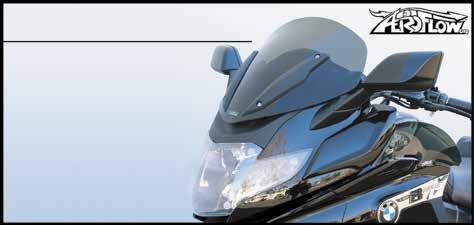
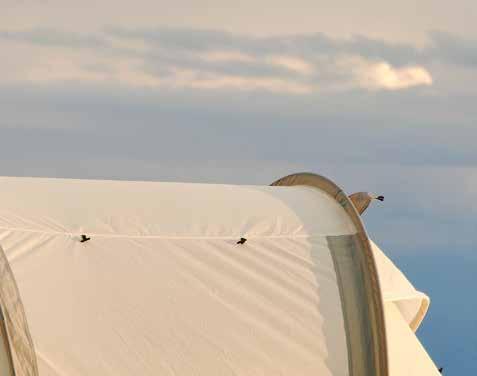


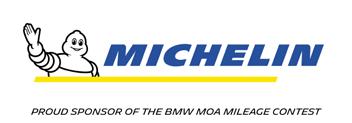
Two changes are in the works for the BMW MOA Mileage Contest. First, Mileage Contest forms used to document beginning and ending mileage will now only be available online at bmwmoa.org. If you want to submit ending mileage for the 2022 Annual Mileage Contest (which closes March 31) or submit beginning mileage for the 2023 Mileage Contest that begins April 1, go to bmwmoa.org/mileagecontest and download the 2022 End Form or 2023 Start Form. Instructions are available to document your mileage and submit the forms.
Next, the third annual Grand Coddiwomple begins April 1 and celebrates the 50th Anniversary of the MOA. We’ve decided to give the Coddiwomple and the Mileage Contest their own space and time in the limelight. The Summer and Annual Mileage contests will be combined into one BMW MOA Mileage Contest that begins April 1, 2023, and ends March 31, 2024. Any miles you ride during the Coddiwomple this summer can be counted toward your Mileage Contest totals. Simply download the Mileage Contest forms, document your beginning and ending mileage, then hit the road for the Codiwomple or any other reason you choose.
The BMW MOA Mileage Contest and the Grand Coddiwomple are two great reasons to ride inspired!
Liqui‐Molyoil ‐ oil, fuel & air filters – 12/24K maintenance kits – brake pads & rotors – fuel pumps – Hall sensors – repair manuals & dvds–tools – fuel line disconnect sets – fuel injection controllers – exhausts – batteries & chargers –master cylinders & rebuild kits – starters – spark plugs & wires – cables – radiator fans – alt belts – fender extenders – Carbtune carb/TB synchronizers
Sometimes I tend to get more serious about my motorcycling than I probably should, especially when it comes to long-distance touring. I mean, how else can I explain my sudden fascination with motorcycling “numbers.” I’m not talking about motorcycle sales numbers or similar. Nope, I am realizing today that I am driven by numbers that are just right for me and perhaps others as well: numbers that make sure I keep enjoying the long riding days I’ve got left with good friends and motorcycles.
What’s the ideal number of riders to have on a long group ride? Before you answer, toss in some facts about the ride: Are we mostly on twisty roads or is it all slab? Does everyone have the same skill set? The same ideal distance between stops? Allowed to dawdle or not at rest stops?
As it turns out, for me the maximum number of riders is five, with the ideal number probably three. That number makes it easier to gas and go, even at a small gas station with few pumps, and avoids worry about running up someone’s rear in the twisties. Only one toilet available? No problem, in theory, and riding with fewer riders lessens the problem of riding at night and wondering where the heck the other riders are in the crowd of lights behind you.
That last thought conjures yet another number. If you’ve had two cups of coffee
at the ride breakfast, how many miles can you roll before you or a buddy will for sure have to “tap a kidney?” Naturally you’ve built that into the ride plan lest you be at the back of the pack, having to get off while the rest of the group roll on without you. With this number in mind, you now also know if you must start the ride with a full tank. Heck no., you’ll be stopping in a hundred miles.
Speaking of fuel, the reserve light just came on. Some of us use our GPS to plot gas stops. I much prefer truck stops when stopping. Imagine yourself in Iowa, heading west and rolling across Kansas or Nebraska into a head wind with a constant uphill grade. When the fuel light comes on in that environment, you know how many miles you have left in that tank, right?
While knowing your tank is nice, knowing your tires is nicer and more insidious, as they always look like they have more or less tread than they really have. In particular, do you always know what’s left in your rear tire? As the saying goes, it is better to be at the dealer wishing you were on the road than on
the road wishing you were near a dealer (ready to drop everything to put the tire you want on your bike which he just happens to have in stock).
For me that task is easy: spend $5 and get a tire depth gauge. Measure the tread depth when your tires are new and then
again after 1,000 miles. How many 32nds did you start with and how many are left? Do the math as you now know the best case for how many miles are left in that tire. If you tend to use the same tires and are meticulous about monitoring tire pressure you will get really comfortable with the actual mileage you can expect, regardless if highway or around town riding is your thing.
Anyway, tire mileage and the just right number is a big deal with me, as I do not want to be on the road on a major trip with 2/32nd of tire left even though the tire wear indicator might not yet be level with the tread. I’m more than happy to throw away $25 or $50 worth of tire wear and put a new tire on before the trip because I don’t want to be anywhere on the trip wishing I was at a dealer.
Apart from knowing how many miles are left in the tank and on the tires, I need to know how many miles are left in ME. As the average age of the rider population continues to uptick, this is not a minor issue. As the subject at hand can open a lot of discussion, I’ll leave it to you to sort it out, but you need to do that.
Miles left in me means riding miles when I’m not a danger to myself or the rest of humanity. For me, that keeps me focused on a couple of issues driven by some truly awful near death touring experiences. Like the time we rolled from Halifax to Vancouver, and I let myself get dehydrated. The leg cramps were so bad I could not sleep one night, which forced me to stop the next afternoon and sleep by the side of the bike. Or the time I decided I needed to get home from Nova Scotia with the Poconos as a mid-way stop, but the previous night I had been camping and had not slept well. I didn’t get started until late afternoon that day and by nightfall was fighting to stay
Introducing the WunderLINQ
Handlebar control of your phone Motorcycle per formance and fault data
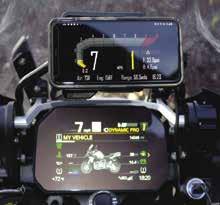

USB power por t embedded.com by
MOTORCYCLE CARRIER



2 - 4 Wheel Air Ride Cargo Carrier for Bikes, Trikes, SXS, Golf Carts, Wheel Chairs • 2 Point Mount to Pickup, 5th Wheel, Travel Trailer, Motorhome, Car, Jeep, SUV • Drive On One Side to Load, Drive Off the Other Side to Unload with Pullout Self Storage 8' Ramps, 24"High • 12 V Power Loader Available in Lieu of Pullout Ramps • YouTube: Sturgis Gerry Piercey 30-40 videos and movies
 4' x 8' Pullout
Drawer Under Deck
4' x 8' Pullout
Drawer Under Deck
awake, knowing that if I didn’t, I’d crash and burn. I got to the Poconos, but pushing my luck was stupid. I may be a slow learner, but once I get it, I don’t forget it.
Lack of sleep impacts my performance, and I know the minimum hours of quality sleep I should strive for and what interferes with it. Dehydration is surprisingly commonplace, and it does not take much to impact performance, and I know what I need to consume in hydrating fluids. Actually, many other things can impact performance, including that harmless beer or two at lunch or even specific meds, some very common ones.
Believe it or not, acetaminophen is reported to REDUCE your perception of risk so that folks taking this common pain reliever are more prone to risky behaviors. The research tested a dose equivalent to the amount of acetaminophen found in two Excedrin headache pills.
The Devine Ms. Cindy is all over the issue of fatigue and is adamant that I stop riding all day and night to get home. If fatigue is the issue, what is the trigger in search of your number? Maybe it’s if you’re riding along and you suddenly realize you can’t recall how you got there. In the worst case, you actually feel yourself nodding off. Are the last 15 miles a blank? Is that your number?
I carry a tent ground cloth, and if I find myself fighting to stay focused, I just park the bike and take a nap. I also know what a cup of coffee or other things mimicking a cup of coffee can and cannot do when it comes to topping off the mental tank. I’ve done my share of 1,500-mile days, but with aging comes a ramped-up concern to get home in one piece. Fatigue freaks me out because you can’t safely attend to your inattention until it’s too late. For some folks, I can see them saying that their ride number is simply the hours of daylight since rolling all night can mean more nodding and other risks.
Speaking of risk, that thought has prompted some other changes for me, including how often I check my mirrors before changing lanes. Call me crazy if
you want, but is it just me or are there ever-increasing numbers of folks in cars post-Covid driving faster and not paying attention? The right lane is no longer the slow lane if it’s the lane the nut cases in cars can use to pass the rest of us.
I’ve become aware that when in the “slow lane,” I look in the left mirror, turn my head back, and pause instead of lane changing, but with that pause some jackass seems to come out of nowhere speeding up to pass me. So, if I don’t look again before I move left, I’d be toast. Or, I’m in the fast lane and some yahoo is on my buttisimo, and if I don’t look in the right mirror one more time, I’ll miss the fact that some other yahoo is speeding up to pass me on the right. Seriously. I know it is not me because a cop as much as said so to Papa Smurf and me on our last Black Friday ride.
It was the prep for the last Black Friday ride that led me to discover my new and likely most consequential number. The forecast was for rain coming up from the south on that Black Friday afternoon which caused the riders leaving in the south to bail out of the ride. So, Papa and I decided to make it a short day to keep the Black Friday ride tradition alive—stay north and make it a short “Ride To Eat” to beat the rain before it arrived.
What better place than a small bar/ restaurant in southern Indiana deserving its place on the Indiana Chicken Trail. Try to envision an Indiana black pepper-laced fried chicken that you will love. I even took along a small cooler to score points with Cindy by bringing some back home. There we are standing around next to our bikes when the town police cruiser rolls up. “Hi Boys!” What did we do? I wondered.
The officer had just stopped to chat and ask us to be careful, noting he no longer rides his Harley recreationally as it is “not safe.” He talked about speeding, and I can still see him mimicking folks in cars steering with their knees while texting on their phones.
Aside from the chicken and the chat I remember the temperature at the start of the day—my new number. Now the

temperature that matters is the temperature the bike display presents, which was 42. What’s the big deal, you ask? Well, the big deal is that I was not using my electric jacket or my electric glove liners or gloves. I was not riding with my rain jacket as a wind block, thus turning my waterproof textile jacket into a layer. I was, as you might expect, running with my heated grips on full load but the windshield was up only a bit. I was having a motorcycle epiphany. I had stumbled on just the right setup for just this temperature, not requiring me to layer with electrics.
And what was that you ask? My LD gear topped by a base layer thin Omni Wool. Then a cheap, puffy easy-to-compress Walmart jacket. That’s it. Now I am not sure if I could roll all day at that temperature, but it is fine now that I’m rolling without a fuel cell and having to stop more often. When I got back home I gave a rained-out Raider a call for a catchup chit chat during which I gave him my epiphany news.
“You don’t mean that’s the high for the day. You mean that’s the low, right?” Yeppers. My days of freezing are over. It’s more fun rolling over 42.
Have fun with your numbers in this post-Covid Mad Max world. See you down your semi-chilly layered up road!
Dancin’ Dave Cwi is a Life Member of the MOA as well as a Premier Member of the Iron Butt Association. He’s owned every series of BMW motorcycle from the Slash 2 to the modern RT, and has burned out his wife, who once loved motorcycling but sold her bikes after two trips with Dave. He pays for his riding addiction via marketing stints, including work in powersports. You will see him down the road.
RIDE AWAY FROM THEM. IT’S A LOT FASTER.
THERAPEUTIC MOTORCYCLE ADVENTURES FOR VETERANS AND FIRST RESPONDERS WITH PTSD (AND OTHER NASTY STUFF)

I tried to take my dog Penny for a walk yesterday. I say “tried” because as soon as I got the dog leashed, my cold weather gear on (including my preposterous, fur-lined cap), and headed down the driveway, I could see that the icy streets and sidewalks held all the promise of a wrenched knee, a broken hip or a mild concussion. As Penny strained at her lead, I couldn’t help but also imagine the possibility of getting towed down the lane behind a 90-pound Lab like a human toboggan. Back to the house we went.

You see, here in northwestern Wisconsin, we’ve had the perfect storm of winter weather in terms of making the sidewalks and residential streets practically impassable. First there was the “bomb cyclone,” dumping a foot and a half of snow, accompanied by double-digit subzero wind chills. Then, those 50-mile an hour winds polished wherever the snow had been compressed into rutted black ice. We know snow in Wisconsin, but repeated snowfalls had gotten ahead of us, and the city’s smattering of sand seemed like a token effort against the four inches of ice.
This winter has gotten so bad, I’ve even turned to Wordle. Not the one-word-a-day New York Times game that my daughter beats me at every day, but an entire Wordle BOOK, which she gave me, either in an effort to pass the home-bound time or to cruelly taunt me, I’m not sure which. And speaking of taunting, I could feel a sneer from my motorcycle on its centerstand in the garage over the maintenance and upgrades I had vowed to do over winter. I have what a friend dubbed a “failure to initiate,” But, in my defense, my garage is unheated, and
besides trying to wrench with fingers frozen into fossilized claws, I knew many of those tasks would require me to lie on the floor in a mixture of car booger slush, de-icer and oil from my prehistoric Ford Ranger. No thanks.
My only salvation from all this? Daydreaming about a ride I took last summer that came pretty close to being perfect. Another MOA member, Randy, had invited me to spend a day wandering over the steep bluffs and deep coulees leading to the banks of the Mississippi in the Driftless Area of western Wisconsin.
With temps in the upper 50s, the sky a robin’s egg blue and the oaks, aspens and maples in their most garish October finery, we set out, Randy choosing his new 310 GS and me on a little Kawasaki, which were ideal choices for this rollercoaster ride. The constant elevation changes, serpentine county and town roads and hairpin turns slowed us wonderfully at times, almost to a crawl, but then suddenly we’d burst into a
straightaway, bordered by brassy cornfields whose dry, papery leaves rustled in the breeze like applause. I was lost in the first mile, so kept Randy in sight as we tooled for a few hours down through the Mississippi and Chippewa River bottoms to Nelson, Wisconsin, on the famous River Road and then across the big river to Wabasha, Minnesota, just off Dylan’s famous Highway 61.
I followed Randy to a little brewpub called Read’s Landing right on the riverfront where we de-briefed over a burger and a brew. Rested and refreshed, we re-crossed the river, and I followed Randy into the parking lot of the locally famous Nelson’s Cheese Factory for ice cream (vets get their cones free), then it was once more into the maze.
I encountered the only wrinkle in the day late in the afternoon–a moment of panic when I topped a sharp turn at the crest of a steep hill. I had purposely slowed and veered right in anticipation of any tractor, lane wanderer or Amish
buggy that might be waiting just over the peak, but instead rolled into a swath of slimy, fresh-cut grass a county scythe had left in my lane. I gently braked, trying to avoid getting too close to the edge of the shoulder and a sheer drop, but still came inches from disaster. The surprise left me tuned back up for the hazards motorcyclists must always anticipate, and the day once more became a rider’s dream.
Some readers are probably thinking, “Well, if he dreads winter so much, why doesn’t he move?” I know California isn’t always earthquaking, mud-sliding, or burning, and I know the South isn’t always tornado-ing or hurricaine-ing. But I have to wonder, would I appreciate a perfect day on a bike as much if I didn’t have all of a Wisconsin winter to pine for it?
SERVICES:

• Motorcycle Transport Sea Freight & Air Freight

• Bike Storage and Service
• Green Card Insurance
• Rental Bikes
• Bed & Breakfast
• And all you need
CONTACT:
Stefan Knopfknopftours@aol.com
www.knopftours.com
Over 40 essays, features, reviews, profiles and memoirs focusing on the two-wheeled life from the author of the acclaimed Shiny Side Up.

I’ve enjoyed Ron Davis’s columns and stories for a long time…he does what all the best motorcycle writing does: he makes you wonder why you aren’t out there riding your own bike, right now, except during the long Wisconsin winter, when his work simply helps you stay sane until spring.”
 —Peter Egan, Author of Leanings 1, 2 & 3
—Peter Egan, Author of Leanings 1, 2 & 3
The best books on motorcycling and adventure travel
ISBN 978-1-890623-74-6, Softcover
252 pages, $19.99 SRP
Ron Davis has been a rider, off and on, for about 40 years. Over that period, he’s also squeezed in a full time career teaching high school and university classes in writing, photography, and publishing while also working as a social media writer for the tourism industry in northwest Ontario and Associate Editor for BMW Owners News His writing has been featured by BMW Owners News, BMW Motorcycle Magazine and The National Writing Project, and his essays, sometimes on motorcycling, can be heard regularly on Wisconsin Public Radio’s “Wisconsin Life.” His recently completed novel for young adults, Sachem Summer, is about love, trout fishing and a BMW R 50/2.
Like so many things, momentum can be friend or foe. When we’re on a roll, getting lots of stuff accomplished, it’s exhilarating how success builds upon success. On the other hand, when an onslaught of Murphy’s Law vectors have converged in quick succession, it’s common to feel demoralized. On our bikes, momentum can carry us through a series of gentle sweepers with effortless grace, or it can make braking for tight, decreasing-radius corners an eye-popping, butt-clenching ordeal. Here I want to talk about another kind of unwelcome momentum—one most of us contend with many days each week, perhaps without even realizing it: stress momentum.
Stress is ubiquitous in modern life. Obviously, there have been stressors present throughout human history, but in the distant past there were periods wherein people could feel safe from certain acute threats. A dangerous animal, for example, would be anxietyprovoking until it had been killed or was distant enough to no longer pose a risk; the same went for an enemy warrior from a competing tribe. Food scarcity could endanger the whole group, but all was well once new supplies were secured. Life involved oscillations between surging fear or aggression and periods of relief. Prey animals of all sorts exhibit a similar pattern and have evolved ways of shaking off (sometimes literally) the instantaneous spike in arousal they need to fight or flee another creature intent on eating them. Their nervous systems return to a quiescent state and they resume their daily activities. Predators don’t necessarily have such an easily flipped switch and may take considerably longer to wind down after an alarmed or aggressive episode. Guess which group we’re in (hint: our eyes are on the front of our heads).
In all these illustrations, the creatures
involved are dealing with concrete dangers that emerge and subside. What makes the modern world different for human beings is the proliferation of abstract dangers that impinge upon us in sustained ways. This is partly a function of the countless complexities of a technology-infused existence wherein we’re perpetually bombarded with information, the vast majority of which has no real or immediate impact on our lives, except in our imaginations. It’s also partly a function of our ability to dwell on memories, possibilities and distant events that carry powerful emotional charges, despite their lack of relevance to our present situations. In the absence of any current, actual threat to our well-being, we can be twisted up in knots of anxiety about the past, the future, or someone or something far, far away. We conjure the related imagery (deliberately or reflexively) and our nervous systems respond with a level of arousal appropriate to the remembered or imagined threats, resulting in a disconnect between our emotional state and our immediate circumstances.
Now, I’m not criticizing anyone (including myself) who experiences this mismatch; it is absolutely normal, albeit far from ideal. For example, while it makes sense to feel concern about retirement savings and take steps to guard against a destitute future, we derive no benefit from losing sleep about it tonight. A past trauma understandably creates lingering sadness, anger and/or wariness, but these can preclude the arrival of joy and connectedness when such would be safe and realistic today. Worrying about a loved one—or even people we don’t really know—is a natural aspect of caring about others and can provide the impetus for altruistic efforts, but when it manifests as rumination that eclipses our awareness of positive developments
around us, it can do as much harm as good. We need to be able to feel distress when such arousal provides the needed energy to protect ourselves and advance our interests, but we also need to be able to take breaks from this state when not under threat.
Our nervous systems contain two large-scale components, the sympathetic and parasympathetic branches. In an oversimplified sense, the former is activating, the latter deactivating. Without getting into the anatomy and neurophysiology of these sub-systems, what’s important in this discussion is that chronic sympathetic overarousal—an uninterrupted stress response—occurs when all the spaces between concrete/immediate threats get filled with abstract/imagined threats, thus keeping our nervous systems on high alert and maintaining an agitated, and ultimately exhausting, mental and emotional condition. Perhaps the worst part of sustained overarousal is the way it builds on itself. If the alarms sound frequently enough, they can eventually just stay on, regardless of anything happening around us. At the very least, the more often they sound, the more easily they’re reactivated going forward. We can develop such a readiness to become scared and/or aggressive, other emotions rarely get any chance to occur. This is the hell endured by people with serious anxiety disorders, like PTSD.
We need ways to engage the parasympathetic portion to restore balance and disrupt the steady accumulation of anxiety, along with all its problematic effects on our mood, concentration, judgment, creativity, interpersonal relations, and physical health (to name only a few of the areas negatively impacted). There are many methods for accomplishing this goal, including regular physical exercise, meditation, breathing exercises and creative or recreational pursuits requiring tightly focused attention on the immediate present (thereby
MARK BARNES, PHD #222400



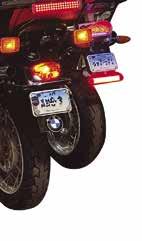




precluding obsessive rumination) without adding even more psychological pressure (e.g., to perform competitively). Motorcycling may fit within this final category, as long as we’re talking about the relaxed/ relaxing version and not dodging busy traffic hazards or racing our buddies through canyon switchbacks. Given how riding inevitably involves moments of acute, concrete threat, we must also have ways of resetting our level of arousal after it has been appropriately heightened. Otherwise, we’ll remain shaken and unable to enjoy the rest of our outing, not to mention less able to utilize our mental resources in the event of another encounter with danger.
After a close call, surely all of us have experienced a cluster of normal responses designed to help us fight or flee. These might occur during the close call, as well, if there’s enough time. They kick in very quickly, but we may be so surprised by a suddenly appearing and quickly dissipating hazard that they arrive only after the danger has already passed. I’m talking about a racing heartbeat, rapidly gulping breath and tensed muscles, all of which would be valuable assets if we were about to evade or engage in combat. Our neurophysiological evolution hasn’t kept up with vehicular advances, so these aren’t ideal responses in the saddle. The best riders/racers may be constitutionally less prone to such reactivity, or they have developed ways of taming it. By the way—our neurophysiological evolution also hasn’t kept up with such stressors as boardroom presentations, tax audits and numerous other elements of modern life wherein fighting or running away are not helpful responses.
When our bodies don’t calm down, our minds can’t calm down, either. The old phrase, “mind over matter,” may be applicable in some other situations, but in this one, our bodies have the leverage advantage over our minds. “Talking ourselves
Redesigned from the ground up. The Light Bar Pro is the most advanced safety lighting product on the market today.
With Bluetooth onboard, the light bar is customizable using the free AdMore App (iOS and Android).
Bosch accelerometer sensor that lets drivers know when you’re slowing down.
With 81 insanely bright Cree LEDs on-board, following drivers stay back! ADMORELIGHTING.COM/BMWON
ORDER YOUR LIGHT BAR PRO TODAY!
down” is likely to be less effective than intervening at the physical level, which is why cocktail hours exist. Subduing our over-aroused nervous systems with a chemical agent may be quick, effective and reliable, but it’s impractical while riding a motorcycle and comes with another set of drawbacks. If we’re not going to keep our hydration bladders filled with bourbon, what’s a frightened and/or enraged motorcyclist to do?
Here are two simple, practical approaches. First, while continuing to ride, breathe in a deliberate manner, replacing the fast, shallow alarm-state pattern with slow, deep inhalations, followed by a brief hold, and then even slower exhalations, making sure to use your diaphragm to push out as much of the old air as possible. Depending on how much concentration you can spare, you might aim for an exhalation about 1.5-2 times the duration of your inhalation, like breathing in to a count of four and out to a count of six or seven. By doing this you are interfering with the perpetuation of the stress response and purposefully rebalancing the sympathetic-parasympathetic equation, since inhalation is associated with sympathetic activity and exhalation is associated with parasympathetic activity. Of course, this technique can be employed in most any other setting, too, and it’s generally invisible to people nearby.
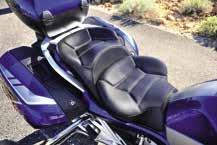
The second method involves getting off the bike, although some limited version may be possible while still on it. This is called “progressive relaxation,” which is a fancy way of describing the systematic tensing and releasing of each major muscle group in the body. Ideally, a rider might spy a convenient place to pull over and stretch out flat on their back, then proceed to focus on the muscles in their feet, then calves, then thighs, then hips, then abdomen, then upper back, then shoulders, then upper arms, then forearms, then hands, then neck, then jaw, and finally their brow. In each sequential zone, they would initially tense the muscles isometrically (holding the bones still and flexing the
surrounding/opposing muscles simultaneously). Flexing the muscles first can allow for a deeper release during the relaxing phase. This also happens to be a good way to ease into sleep for folks who—wittingly or unwittingly—bring significant bodily tension with them to bed. While still riding, it can make a surprisingly big difference to just let our arms and shoulders drop while relaxing our death-grip on the bars.
After some deliberate breathing and muscle relaxing, the body will be in a calmer state, allowing the mind to move in the same direction more easily. Different people will respond at different speeds and to different degrees, depending in part on how high their baseline levels of arousal are, and how much practice they have with these strategies. The more familiar they are, the better they work. Merely scheduling 5-10 minutes of deliberate relaxation in the middle of the morning and the middle of the afternoon can yield a substantial decrease in the amount of tension at the end of the day.

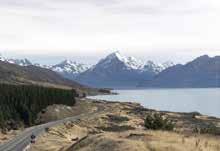
I’ve not yet met someone with a shortage of stress in their life, though I have met some people with well-developed means of decompressing, and thereby interrupting the momentum and accumulation of the stress response. All of us would do well to practice a variety of (non-chemical) means of doing so during our daily routines; our lives in and out of the saddle will benefit greatly.
Mark Barnes is a clinical psychologist and motojournalist. To read more of his writings, check out his book Why We Ride: A Psychologist Explains the Motorcyclist’s Mind and the Love Affair Between Rider, Bike and Road, currently available in paperback through Amazon and other retailers.



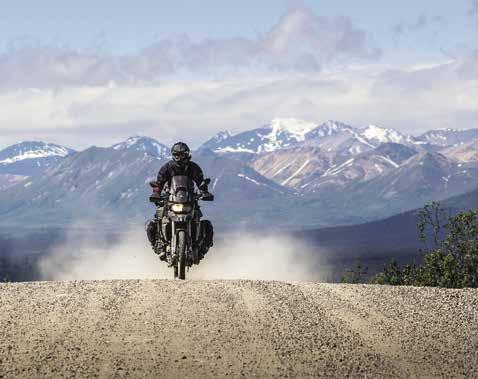


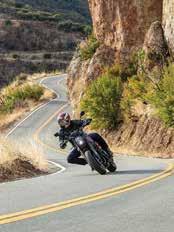




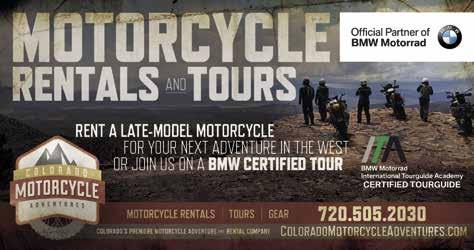




4/21/2023 – 4/23/2023
CAMPOUT AT THE SONGDOG RANCH Maricope, California tourcaptain@bmwnorcal.org
5/25/2023 – 5/29/2023
BMW CLUB OF NORTHERN CALIFORNIA 49ER RALLY Mariposa, California 49erchair@bmwnorcal.org
6/22/2023 – 6/25/2023
43RD ANNUAL CHIEF JOSEPH RALLY John Day, Oregon bmwro.vp@gmail.com
6/24/2023 – 6/25/2023
CAMPOUT AT UNCLE TOMS CABIN Pollock Pines, California tourcaptain@bmwnorcal.org
7/13/2023 – 7/16/2023
CASCADE COUNTRY RENDEZVOUS Cashmere, Washington rallymaster@wsbmwr.org
7/28/2023 – 7/30/2023
CAMPOUT AT BEAR RIVER Colfax, California tourcaptain@bmwnorcal.org
8/26/2023 to 8/27/2023
CAMPOUT AT BADGER FLATS Lakeshore, California tourcaptain@bmwnorcal.org
10/28/2023 – 10/29/2023
OCTOBERFEST
Manchaster, California tourcaptain@bmwnorcal.org
5/5/2023 – 5/7/2023
MOA GETAWAY AT SANTA FE Santa Fe, New Mexico membership@bmwmoa.org
7/20/2023 to 7/23/2023
TOP O’ THE ROCKIES RALLY Paonia, Colorado torrallymaster@bmwmcc.co
9/22/2023 – 9/24/2023
19TH THUNDER MOUNTAIN RENDEZVOUS Hotchkiss, Colorado aesurvey@aol.com
4/14/2023 – 4/16/2023
HILL COUNTRY HANGOUT Kerrville, Texas makowski.michael@gmail.com
4/16/2023
39TH WILD GOOSE RUN Beaver Dam, Wisconsin brianjustman@kewaskumpig.com
4/19/2023 – 4/23/2023
22ND RENDEZVOUS (RDV) Tellico Plains, Tennessee hans.c.koeller@gmail.com
4/28/2023 – 4/30/2023
GREEN COUNTRY OKLAHOMA ADVENTURE TOUR Moodys, Oklahoma jgifford@bmwmoa.org
5/6/2023
2023 MOTORCYCLE FLEA MARKET AND MOTOEXPO
Leaf River, Illinois
Earve Brauer
5/19/2023 – 5/21/2023
GREAT RIVER ROAD RALLY Soldier’s Grove, Wisconsin rally@madisonbmwclub.org
6/1/2023 – 6/4/2023
LAND OF OZ RALLY
Paola, Kansas moa_84843@yahoo.com
6/2/2023 – 6/4/2023
46TH HIAWATHA RALLY Houston, Minnesota murdaughm@gmail.com
6/23/2023 – 6/25/2023
MOTOMO RALLY 2023 Crane, Missouri kronie12@gmail.com
9/8/2023 – 9/10/2023
52ND ANNUAL WISCONSIN DELLS RALLY Wisconsin Dells, Wisconsin barnrazer@yahoo.com
9/21/2023 – 9/24/2023
2023 PURE STODGE IOWA RALLY Elkader, Iowa pstarally@gmail.com
11/3/2023 – 11/5/2023
53RD SOUTH-CENTRAL BMW OWNERS REUNION Fayetteville, Texas vp@bmwclubofhouston.com
4/21/2023 – 4/23/2023
MOA GETAWAY AT FONTANA Fontana Dam, North Carolina membership@bmwmoa.org
5/3/2023 – 5/7/2023
BMWS TAME THE TAIL OF THE DRAGON Robbinsville, North Carolina qbird66@gmail.com
5/5/2023 – 5/7/2023
GEORGIA MOUNTAIN RALLY Hiawassee, Georgia rally@bmwmcoga.org
5/5/2023 – 5/7/2023
9TH BATTLEFIELD MEMORIAL WORKERS RALLY Gettysburg, Pennsylvania samrbooth@yahoo.com
For complete details on any event listed, please visit bmwmoa.org and click on the Rallies & Events tab
5/18/2023 – 5/21/2023
EUROPEAN RIDERS RALLY Burkesville, Kentucky ridersrally@bmwmcon.org
5/19/2023 – 5/21/2023
35TH ABC RALLY Aylmer, Ontario johnnydundas@gmail.com
5/19/2023 – 5/21/2023
31ST DOWNEAST RALLY Poland, Maine rally@bmwrsm.org
5/20/2023 – 5/21/2023
NEW SWEDEN 450 Mt. Laurel, New Jersey rcesaretti@comcast.net
2023
Flea Market and MotoExpo
37th Annual
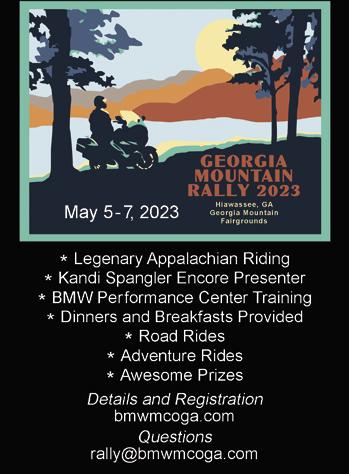
Welcoming: BMW and All Marques from Europe and Japan!
6/2/2023 – 6/4/2023
48TH ANNUAL SQUARE ROUTE RALLY Sabillasville, Maryland rally@bmwbmw.org
6/8/2023 – 6/11/2023
50TH ANNUAL MOA NATIONAL RALLY Doswell, Virginia ray@bmwmoa.org
6/10/2023
THE SELECTED FRIENDS OF WILE E. COYOTE RALLY GET-TOGETHER Doswell, Virginia
J. J. Dostal 810-624-5987
8/4/2023 – 8/7/2023
INTERNATIONAL ROLLING BROCOLLI Vassar, Michigan
J. J. Dostal 810-624-5987
NEW Indoor Venue!
River Valley Complex in Leaf River, IL
605 Main St, Leaf River, IL 61048
GPS Coordinates: 42.12145, -89.40345
Admission - $5 donation
NEW Date!
Saturday, May 6, 2023
Vendors: Setup 7:00a - 10:00a
Shoppers: Open 8:00a for breakfast, then 10:00a - 5:00p for shopping
For More Info
Go to: blackhawkbmwclub.org
<<NEW VENUE photos: On website, click Photo Gallery and then on SmugMug, open 2023 folder.>>
On Facebook: Blackhawk Region BMW Club Or contact: Earve Brauer 815-962-8911

rockbmw2000@yahoo.com
9/8/2023 – 9/10/2023
KENTUCKY STATE BMW RALLY Pineville, Kentucky prorepoms@aol.com
9/22/2023 – 9/24/2023
36TH ANNUAL HOOSIER BEEMER RALLY North Vernon, Indiana k12lts@gmail.com
10/8/2023 – 10/22/2023
BMW MOA & IMTBIKE CELEBRATION TOUR OF SPAIN Madrid, Spain tours@imtbike.com




Managing Editor BILL WIEGAND | bill@bmwmoa.org
Art Director KARIN HALKER | karin@bmwmoa.org
Digital Media Editor WES FLEMING | wes@bmwmoa.org
Associate Editor RON DAVIS
A ssociate Editor JOSE ABILES
Ely Woody, Don Wreyford, Scott Magruder, Mike Tice, Graham Kier, Terence Hamill, Jack Chermak, Jake Meadows, John Deikis, Wes Fleming, Johnathan Gifford, Matt Goff, Dustin Silvey, Mark Thompson, Matt Parkhouse, Owen Bower, John “JP” Privette, Nick Ienatsch, Jim Low, David Cwi, Ron Davis, Mark Barnes and Monica Padberg.
Advertising Director CHRIS HUGHES | chris@bmwmoa.org
Business Development Director CHAD WARNER | chad@bmwmoa.org
Executive Director TED MOYER | ted@bmwmoa.org
BMW MOA Headquarters 2350 Hwy. 101 South, Greer, SC 29651 (864) 438-0962
Membership in the BMW Motorcycle Owners of America is open to all riders, regardless of brand affiliation. Although we are united by the BMW marque, adventure-minded motorcyclists will find a home here. Join today by visiting bmwmoa.org or call one of our friendly membership associates at 864-438-0962.
Primary Annual memberships are available in one year, two year or monthly options. Additional membership options include Primary Membership with Basic 25/100 Roadside Assistance, Primary Membership with Platinum Roadside Assistance, Digital Membership with Basic 25/100 Roadside Assistance, Digital Membership with Platinum Roadside Assistance. We also offer Roadside Assistance without an MOA Membership.
For a complete listing of membership options, please visit bmwmoa. org or call 864-438-0962.
WWW.BMWMOA.ORG
BMW ON (ISSN:1080-5729) (USPS: 735-590) (BMW Owners News) is published monthly by BMW Motorcycle Owners of America Inc., 2350 Hwy 101 South, Greer, SC 29651. Periodicals postage paid at Pewaukee, Wisconsin and additional mailing offices. Opinions and positions stated in materials/articles herein are those of the authors and not by the fact of publication necessarily those of BMW MOA; publication of advertising material is not an endorsement by BMW MOA of the advertised product or service. The material is presented as information for the reader. BMW MOA does not perform independent research on submitted articles or advertising.
POSTMASTER: SEND ADDRESS CHANGES TO BMW ON, 2350 Hwy 101 South, Greer, SC 29651 © 2020 by BMW Motorcycle Owners of America Inc. All information furnished herein is provided by and for the members of BMW Motorcycle Owners of America, Inc. Unless otherwise stated, none of the information (including technical material) printed herein necessarily bears endorsement or approval by BMW MOA, BMW NA, the factory or the editors. The editors and publisher cannot be held liable for its accuracy. Printed in the USA. Volume 53, Number 3
 Western Beauty
Riding amid the golden sandstone, canyons and striking rock formations of Utah’s Capitol Reef National Park.
Western Beauty
Riding amid the golden sandstone, canyons and striking rock formations of Utah’s Capitol Reef National Park.
“
Riding motorcycles is my passion, my hobby, and what makes me “self-actualize”. I’ve been riding for more than 45 years now, and have had many street and dirt bikes, ranging from a Yamaha DT175 to a Moto Guzzi V11 LeMans, to a BMW RT. In 2015 I purchased a new Wethead R1200RT. It is by far the nicest and most luxurious bike I have owned, and is a real mile cruncher. It has also been trouble free, and easy to maintain (apart from the ridiculous task of changing the air filter). Each Spring/Summer I go for a very long ride to clear my mind and enjoy the road. I hope to attend some BMW MOA rallies in the future.”


Do you know someone who would like to join?
Scan the code and give them their first year of membership free. Enter the activation code 50YRSON.
* First year free membership offer available to new MOA members only.

– Ivan Townshend #231405



